| John Prine: "Sweet Revenge" (Atlantic, 1973) |
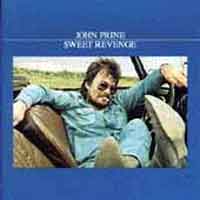 Bereits das dritte tolle Album des Mannes, der uns allen den "Angel From
Montgomery" brachte. Wie immer dabei als Gitarrist Steve Goodman,
selber ein vorzĂĽglicher Songschreiber ("City Of New Orleans"),
dieses mal unterstĂĽtzt von der vorzĂĽglichen Nashville-Mafia
(Reggie Young, David Briggs, Kenny Malone, Grady Martin, u.a.),
als Produzent wie immer dabei Atlantic-Legende Arif Mardin.
Bereits das dritte tolle Album des Mannes, der uns allen den "Angel From
Montgomery" brachte. Wie immer dabei als Gitarrist Steve Goodman,
selber ein vorzĂĽglicher Songschreiber ("City Of New Orleans"),
dieses mal unterstĂĽtzt von der vorzĂĽglichen Nashville-Mafia
(Reggie Young, David Briggs, Kenny Malone, Grady Martin, u.a.),
als Produzent wie immer dabei Atlantic-Legende Arif Mardin.
|
| Bert Jansch: "L.A. Turnaround" (Charisma, Sept. 1974 * Virgin, 2009) |
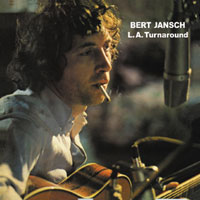

 Mehr ...
Mehr ...
Das wunderbare 73er Charisma Album, produziert von Michael Nesmith, aufgenommen mit Klaus Voorman, Red Rhodes, Jesse Ed David, Byron Berline, Danny Laine etc. Kommt mit drei Alternativversionen, einer Weihnachtssingle und einem 13-minütigen Film von den Sessions. Von Bert Jansch feinst remastert, mit überarbeitetem Booklet, Memorabilia und Linernotes - erstmals auf CD erhältlich.
(Glitterhouse)
|
| Tom Liwa: "Stäfa/CH" (Glitterhouse/Return To Sender, Jan. 2001) |
|
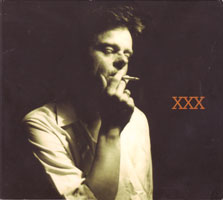 Ein Konzertmitschnitt vom Oktober 1999 (?) aus der Schweiz. Drei schöne
Coversongs: Nick Drakes "Northern
Sky", rarer Dylan ("New Pony" vom Album "Street
Legal") und rarer Neil Young ("Little Wing"
von "Hawks & Doves").
Ein Konzertmitschnitt vom Oktober 1999 (?) aus der Schweiz. Drei schöne
Coversongs: Nick Drakes "Northern
Sky", rarer Dylan ("New Pony" vom Album "Street
Legal") und rarer Neil Young ("Little Wing"
von "Hawks & Doves").
(04.06.2009)
Noch eine bislang ĂĽbersehener Glimmstengel ...
(30.03.2018)

 Mehr ...
Mehr ...
"Stäfa/CH" ist der Mitschnitt eines Live-Konzertes aus dem Kulturkarussells Rössli in, genau, Stäfa. Das liegt am Zürichsee, übrigens.
Aufgenommen im Oktober `99, ist dies nicht ein üblicher, liebloser Live-Mitschnitt - lebendig zwar, aber diszipliniert, in 1A-Qualität. Was in diesem Zusammenhang bedeutet, dass LIWA in all seiner Klarheit und verzweifelter Rechtschaffenheit pur und unverfälscht präsentiert wird. Solo. Der Königsweg: Ein Mann, eine Gitarre, ein ganz kleines bisschen Piano, ein Herz und Lieder. Lieder von unaufdringlicher Grösse, Lieder, die dem Hörer unvermittelt seinen Platz als Krümel im Kosmos zuweisen. Ohne dies wirklich zu wollen. Man wird unwillkürlich demütig, wenn LIWAs Persönlichkeit sich durch seine Songs offenbart. Immer schon war es eine Glaubensfrage unter den Begeisterten: ist Tom nun mit Band oder doch eher ganz allein, ganz auf sich selbst bezogen, der wahre LIWA. Die Antwort: Es geht beides. Aber solo, das kann ich Euch sagen, ist der Mann nicht einer von vielen im Paradies der Ungeliebten.
Seitdem er anno tobak mit den Flowerpornoes das krude, an Realitäten und emotionalen Machbarkeiten geschulte eher un-dramaturgische Element in ein ansonsten sich eher durch Stile definierendes Pop-Umfeld einbrachte, habe ich mich immer mal wieder für ihn interessiert. Immer war er weniger schnoddrig/lakonisch als Tilman Rossmy, weniger abseitig/cool als Nils Koppruch, weniger, nunja, Pop-Diskurs als Jochen Diestelmeyer. Mamas Pfirsiche, mein Gott, dieses Cover. Und überhaupt: Habt ihr TOM LIWA mal live gesehen? Immer eine Freude. Ich durfte ihn zuletzt beim Haldern Open Air auf einer grossen, grossen Rockbühne erleben. Ganz alleine stand er da, zur besten Zeit. Spielte zwischen all den lauten, hippen, mindestens achtköpfigen "Acts". Und selten habe ich jermanden eine solch haarsträubende Situation mit solcher Würde meistern sehen. "Abgeklärtheit" ist da das falsche Wort, es hatte fast etwas Sprirituelles, wie die Menschen ihm tatsächlich zuhörten, nicht nur, weil er, so einsam und verlassen, ihnen in diesem Rahmen u.U. leid tat. Ich & ich eben. Er hat es einfach gemacht.
Auf "Stäfa/CH" sind die Bedingungen andere, einfache. Sein Terrain. Er lässt sich nicht zu Routine hinreissen. Er ist ganz da. Auch hier ist LIWA der zarte, kleine grosse Mann. Der keine Aussage darüber zulässt, ob er nun nach wie vor verletzlich Leid zu Lied macht, oder ob er, gestählt durch das Leben als solches, mit allem, was so dazugehört, sich in einem sakrosankten Taumel wiederfindet. Hatte man bei Christian Brückners Version von "Wir haben die Musik" (gesprochenes Wort, auf LIWAs letztem Album "St. Amour") irgendwie störenderweise den DeNiro vor sich, war das also immer etwas zu viel des Guten, so hört man hier LIWA selbst wirklich zu, ohne abstrahieren zu müssen. Das ist Wahrhaftigkeit, wie sie nur wirklich Gute auszeichnet. Sonst noch: "Stunde des Zweifels", aus dem Ungeliebten-Paradies bekannt. Und eine Auswahl sehr stilsicher dargebotener Coverversionen, Nick Drakes "Northern Sky" etwa, oder zwei eher weniger populäre Songs von eher sehr populären Grössen: Dylans "New Pony" (von "Street Legal") und Neil Youngs "Little Wing" (von "Hawks & Doves"). Zehn weitere unbekannte oder neue LIWA-Originale, einige davon eher Miniaturen, einige ausgearbeitete Geschichten, sind hier nie "für die linke Spur zu langsam, für die rechte Spur zu schnell". Ein durch und durch schönes Album. Wie der Mann, so sein Werk: Würdevoll und gross.
Die Welt: Bereichert.
(Glitterhouse)
|
| Terry Callier: "What Color Is Love" (Cadet, März 1973) |
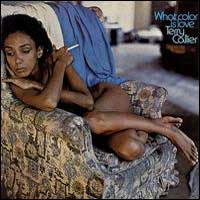 Diese Platte habe ich ja schon bei den Cover Girls
vorgestellt. Der Glimmstengel ist mir erst aufgefallen, als ich mir kĂĽrzlich die Vinylversion
dieses grandiosen Albums gegönnt habe!
Diese Platte habe ich ja schon bei den Cover Girls
vorgestellt. Der Glimmstengel ist mir erst aufgefallen, als ich mir kĂĽrzlich die Vinylversion
dieses grandiosen Albums gegönnt habe!
(30.03.2018)

 Mehr ...
Mehr ...

»What Color Is Love« von TERRY CALLIER aus dem Jahr 1973 ist ein essentielles Soul Jazz Album, das in jede Plattensammlung gehört.
Das Album wurde von Charles Stepney produziert, dessen Arbeit mit Cadet / Chess Records, ROTARY CONNECTION und EARTH, WIND&FIRE ihm einige Lorbeeren einbrachte.
Mit Funk, Rock, Folk, Jazz und sogar klassischen Einflüssen schraubt sich Sänger CALLIER hier auf höchste Höhen.
»Dancing Girl« bildet den Auftakt mit monumentaler Orchestrierung. Songs wie »What Color Is Love« und das elegante Antikriegs-Gebet »Ho Tsing Mee« schaffen es, Klischees zu umgehen.
CALLIERS leidenschaftliche Stimme bildet das Drama des menschlichen Lebens ab. Ein Muss fĂĽr jeden Musikkenner.
When I heard that Terry Callier passed away at the disappointingly young age of 67, I didn’t plan to post anything, as I assumed all the many obituaries would have it covered. But beyond the numerous recaps of his bio and career, I feel like his work is still being neglected even after his death. Particularly, what a badass, underrated record his third album, What Color Is Love? (1973) is. I could also mention that from what I read, what a down-to-earth, humble guy he seemed to be, kind of reminding me of Bill Withers, who posed for one of his album covers holding his lunchbox on break from his day job. And how he took a long break from the music business to raise his daughter by himself while working as a computer programmer at the University of Chicago. Or how he was childhood buds with Curtis Mayfield and Jerry Butler, performed in doo-wop groups, and established a unique style of folk/jazz/soul as early as 1964. But what many are neglecting to mention is that some of his work measures up to the best of not only his old friend Curtis Mayfield, but also Stevie Wonder, Marvin Gaye, Al Green and Donny Hathaway. Occasional Rain (1972) and I Just Can’t Help Myself (1974) are pretty great too. But in my humble opinion, I think What Color Is Love? beats out Al Green’s Let’s Stay Together (1971), Donny Hathaway’s Extension Of A Man (1973), Mayfield’s Back To The World (1973), both Marvin Gaye’s Let’s Get It On (1973) AND (challenging opinion here) What’s Going On (1971), Stevie Wonder’s Music Of My Mind (1972) and Fulfillingness’ First Finale (1974) and kicks the living shit out of every album Isaac Hayes ever did. Pay tribute to the man and buy the album and decide for yourself! RIP T.C.
(www.fastnbulbous.com)
|
| Tom Verlaine: "WordsFrom The Front" (Virgin, Juni 1982) |
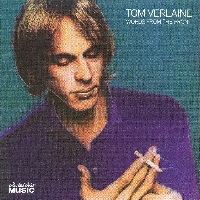 Drittes Soloalbum des ehemaligen Chefs von Television.
Drittes Soloalbum des ehemaligen Chefs von Television.
(26.01.2017)

 Mehr ...
Mehr ...

Tom Verlaine's second solo album, Dreamtime, was easily the finest music he'd created since Television's Marquee Moon. It was so perfectly realized that one wondered what he could do to top it, and when 1982's Words from the Front was released, the obvious answer was that he hadn't; while it's hardly a bad album, the songs don't rank with Verlaine's best work, and though his guitar work is superb as always, he doesn't appear to be breaking much new ground, content for the most part to recycle ideas he'd worked through in the past. Of course, given the sterling quality of Verlaine's work, an album could be quite good and fall below his average, and that's certainly the case here; the butterfly solos on "True Story," the ominous but lyrical wartime tale of the title cut, and the loopy romanticism of "Postcard from Waterloo" are certainly a pleasure to hear. But most of the other tracks suggest Verlaine was treading water, and, overall, the album lacks the cool but steely passion that made Dreamtime a high-water mark in his solo career. If you've never heard Tom Verlaine's work, Words from the Front may well dazzle you with its fluid, atmospheric solos and brittle lyricism, but if you're a fan, you'll probably come to the conclusion that he can do better than this.
(by Mark Deming, All Music Guide)
|
| "Rickie Lee Jones" (Warner, April 1979) |
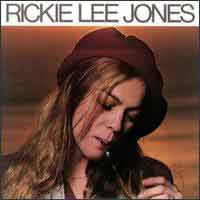 Wenn es eine coole Sängerin gibt ... dann ist das natürlich Rickie Lee Jones!
Wenn es eine coole Sängerin gibt ... dann ist das natürlich Rickie Lee Jones!
(26.01.2017)

 Mehr ...
Mehr ...
With her expressive soprano voice employing sudden alterations of volume and force, and her lyrical focus on Los Angeles street life, Rickie Lee Jones comes on like the love child of Laura Nyro and Tom Waits on her self-titled debut album. Given the population of colorful characters who may or may not be real people that populate her songs -- Chuck E., Bragger, Kid Sinister, and others -- she also might have had Bruce Springsteen in her bloodline (that is, the Springsteen of his first two albums), and her jazzbo sensibility suggests Mose Allison as a grandfather. Producers Lenny Waronker and Russ Titelman, who know all about assisting quirky singer/songwriters with their visions, have brought in a studio full of master session musicians, many of them with jazz credentials, and apparently instructed them to follow Jones' stop-and-start, loud-and-soft vocalizing, then overdubbed string parts here and there. The music thus has a sprung rhythmic feel that follows the contours of Jones' impressionistic stories about scuffling people on the streets and in the bars. There is an undertow of melancholy that becomes more overt toward the end, as the narrator's friends and lovers clear out, leaving her "Standing on the corner/All alone," as she sings in the final song, "After Hours (Twelve Bars Past Goodnight)." It's a long way, if only 40 minutes or so, from the frolicsome opener, "Chuck E.'s in Love," which had concluded that he was smitten by "the little girl who's singin' this song." But then, the romance of the street is easily replaced by its loneliness. Rickie Lee Jones is an astounding debut album that simultaneously sounds like a synthesis of many familiar styles and like nothing that anybody's ever done before, and it heralds the beginning of a potentially important career.
(by William Ruhlmann, All Music Guide)
|
| Heidi Berry: "Below The Waves" (Creation, 1989) |
 Das Debüt der Sängerin beim Indie-Label von Alan McGee.
Danach gab's noch drei Alben bei 4AD, bevor es ruhig um sie wurde.
Das Debüt der Sängerin beim Indie-Label von Alan McGee.
Danach gab's noch drei Alben bei 4AD, bevor es ruhig um sie wurde.
(18.10.2016)

 Mehr ...
Mehr ...
After the generally good vibes of Firefly, the starker performances on Below the Waves must have come as a surprise to many of Heidi Berry's fans. Without changing her excellent singing in the slightest, Berry and her arranger, Christian Lunch, replaced the light folk-rock of Firefly with a more ambient and, often times, quite haunting backing. Brother Christopher Berry's fine acoustic guitar work stays at the center -- but stripped of the band, both it and her vocals stand out with a gorgeous clarity, accentuated by a soft layer of reverb applied throughout the disc. Her lyrics are much clearer as well; her calm detailing of "blood on your hands" in "Little Tragedy" could easily have been lost in the mix had the song been performed on Firefly. Not everything is sonically downbeat -- sprightly guitar helps add a slight musical jauntiness to "Riversong" -- but generally, though, Below emphasizes ruminative lyrics and calm music. The title track is especially fascinating, with a low rumble of sound beginning and ending the song on a slightly disturbing note. Violin and cello appear on a number of songs, deepening the melancholy and sorrowful undertow of many of them. By no means, however, is the record a specifically sad one. If anything, Berry seeks to bring out a careful reflection through her music, as on the lengthy, powerful "Northshore Train," with such slice-of-life observations as "the electric towers stand in line on water's edge." A number of tracks favor keyboards or pianos instead of guitar, often to grand effect: The slow combination of organ swells and bass notes on "Gather All the Hours" creates a lovely bed for Berry's singing. Ending with the elegant "Dancer," Below is an underrated treasure.
(by Ned Raggett, All Music Guide)
|
| "Guy Clark" (Warner, 1978) |
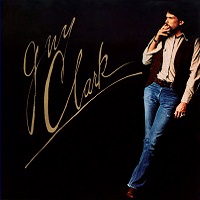 Und nochmals: Einer der besten amerikanischen Singer/Songwriter aus dem
Grenzbereich Folk/Country mit seinem titellosen, dritten Album.
Und nochmals: Einer der besten amerikanischen Singer/Songwriter aus dem
Grenzbereich Folk/Country mit seinem titellosen, dritten Album.
(28.09.2016)

 Mehr ...
Mehr ...
On his Warner Brothers debut and third album overall, Guy Clark made a hard turn to a more polished country sound -- though it was hardly the "hard" country of Conway Twitty. It was also the most experimental record he'd released to date, cello, clavinet, and harpsichord gracing some of the tunes, and a backing band that included Albert Lee, Buddy Emmons, and Mickey Raphael, among others. Backing vocalists, always a part of Clark's recordings, included Don Everly, the Whites, and Rodney Crowell as well as a young, previously unrecorded Kay Oslin (later K.T. Oslin). Rather than pen everything himself, Clark wrote only half the tunes on the record; the others came from Townes Van Zandt ("Don't You Take It Too Bad"), Rodney Crowell ("Voila, an American Dream"), and Jimmie Rodgers ("In the Jailhouse Now"), among others. Clark's touch was at once more pastoral and more honky tonk, the folky traces of the RCA albums vanished inside tracks like "Houston Kid," the Van Zandt tune, and "Comfort and Crazy." It's only in the open-wound "Fool on the Roof Blues" that Clark allows himself the same lightheartedness he did on the earlier records. This is a fine label debut, and if Clark hadn't recorded those two albums for RCA, it might have sounded like a great one. The end result, however, is an artist trying new things and trying to grow, coming up with a handful of real gems in the process.
(by Thom Jurek, All Music Guide)
|
| Steve Young: "Honky-Tonk Man" (Mountain Railroad, Aug. 1975) |
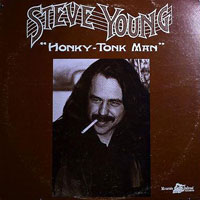 Einer der besten amerikanischen Singer/Songwriter aus dem Grenzbereich Folk/Country
mit seinem dritten Album.
Einer der besten amerikanischen Singer/Songwriter aus dem Grenzbereich Folk/Country
mit seinem dritten Album.
(04.09.2016)

 Mehr ...
Mehr ...
1975 marked the return to the recording scene for Steve Young. Honky
Tonk Man, released on Wisconsin's tiny Mountain Railroad Records, was
his first recording since Seven Bridges Road in 1971 (which had been reissued
in 1973). This is the most straight-up country record Young ever cut.
He handles both lead and rhythm guitar chores with a band of fine session
players, including Kamau Gravatt, who did double duty with Weather Report.
Other than redos of Utah Phillips' "Rock, Salt & Nails"
and his own "White Trash Song," Young sticks somewhat close
to the canon of classic country with a few surprises -- at least on side
one; side two is mostly his own material. The deep blues read of Bob Wills'
"Brain Cloudy Blues" is radical and as far from Western swing
as it gets, but it also showcases Wills' own roots in the blues. The title
cut is a version of the Johnny Horton classic with swinging fiddles by
Craig Ruble and Cal Hand's warbling pedal steel kept in line by Bill Petersen's
electric bass. Young's vocal is a reedy baritone that gets to the heart
of matter -- that this is a drinking playboy's anthem. Side one eclipses
with a high, lonesome take on Hank Williams' "Ramblin' Man"
that is as cur-dog low as it is restless and a cover of Robbie Robertson's
"The Night They Drove Old Dixie Down." Young's version is pastoral
and slow; it's as mournful as a funeral song and comes across as a folk
elegy for the Deep South at the end of the Civil War. Side two is marked
by Young's own stunner, "We've Been Together on This Earth Before,"
"Vision of a Child," and two live cuts done with Doc Watson
of the traditional "Sally Goodin'" and the spooky country of
"Travelin' Kind." Like Seven Bridges Road, Honky Tonk Man is
a fine outing from Young, though it is hampered a bit by somewhat shoddy
recording. But the material and his performance of it are top-notch. The
remastered CD greatly improves the sonics and is worth the extra money
the import costs.
(by Thom Jurek, AMG)
|
| Antonio Carlos Jobim: "Stone Flower" (CTI, 1970) |
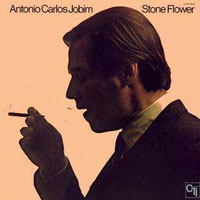 Wenn Tom Jobim nicht zu den Cool Smokers gehört,
wer dann? Auf diesem Album von Creed Taylors Smooth-Jazz-Label
wird der beste Komponist des Bossa Novas von den allerbesten Musikern
aus Brasilien und den USA begleitet. Den Titelsong kennt vielleicht der
eine oder andere in der Coverversion von Santana (!), zu finden
auf deren Meisterwerk "Caravanserai".
Wenn Tom Jobim nicht zu den Cool Smokers gehört,
wer dann? Auf diesem Album von Creed Taylors Smooth-Jazz-Label
wird der beste Komponist des Bossa Novas von den allerbesten Musikern
aus Brasilien und den USA begleitet. Den Titelsong kennt vielleicht der
eine oder andere in der Coverversion von Santana (!), zu finden
auf deren Meisterwerk "Caravanserai".
(31.07.2016)

 Mehr ...
Mehr ...
Zum Bossa Nova schien fast alles gesagt zu sein, als um 1970 die Szene auf zwei Jahrzehnte Musizierstil aus der Synthese von Samba und Cool-Jazz Elementen zurückblickte. Experimentierfreudige Musiker wie Luis Bonfa, Baden Powell, Charly Byrd, Joăo und Astrud Gilberto und der Saxofonist Stan Getz gaben der ›neuen Sache‹ Feuer wie Sentiment. Allen voran steht Carlos Antonio Jobim, der seine Ohrwürmer wie das tickende und schiebende Stück »Desafinado« und den genialisch eintönigen »One Note Samba« auf Weltreise schickte.
Dass es für den Mann aus Ipanema noch immer viel zu sagen gab, zeigt dieses Album, das Jobims kreatives Profil auf dem Höhepunkt seine Reife abbildet. Bereits im ersten Titel, in dem Urbie Green an der Posaune »Tereza My Love« in den reinsten und höchsten Tönen besingt, wird spürbar, dass die Spätlese des Bossa den stilbildenden Rhythmus weitaus feingliedriger strukturiert als die tanzfiebrige Frühreife. Gleichsam mit glänzenden Gold- und Silberfäden werden die Melodien rhythmisch umwoben, verdichtete Klangwellen bleiben duftig und zart. Und doch lassen die Akteure auch die Samba-Pferde von der Leine, wenn es im Latin-Klassiker »Brazil« knackig klöppelt.
Klangzauberer Deodato als Arrangeur und Dirigent und Rudy van Gelder an der Audio-Technik runden diese LP zu einem Meisterstück des Bossa-Repertoires, womit nun wirklich alles gesagt sein sollte.
»Stone Flower« - Antonio Carlos Jobim (p, el-p, v, voc, g); Joe Farrell (ss); Urbie Green (tb); Hubert Laws (fl); Eumir Deodato (g, arr, cond); Harry Lookofsky (v); Ron Carter (b); Airto Moreira, Everaldo Ferreira (perc); Joăo Palma (dr)
»Herrlich.« (Good Times, April / Mai 2015)
»... dieses perfekt gepresste 180-Gramm-Reissue bringt den alten Zauber, der wie der Soundtrack jener Epoche wirkt, ins Heute hinüber.«
(Stereo, Juli 2015)
|
| Ryan Adams: "Heartbreaker" (Bloodshot, 2000) |
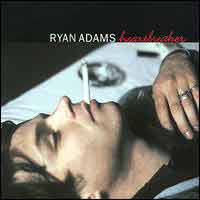 Als ich mir vor kurzem Ryans DebĂĽtalbum auf Vinyl zugelegt habe,
da ist mir auch endlich aufgefallen, dass auch er zu den Cool Smokers
gehört!
Als ich mir vor kurzem Ryans DebĂĽtalbum auf Vinyl zugelegt habe,
da ist mir auch endlich aufgefallen, dass auch er zu den Cool Smokers
gehört!
(24.07.2016)

 Mehr ...
Mehr ...
|
"So ziemlich das beste Album des Jahres 2000. Hat natürlich
schon jeder." (Glitterhouse)
|
|
| "Der Plattentitel ist ein Warnsignal. Wer dieses Album
auflegt und seine verzweifelten, abgewrackten Songs hört, wird nicht
ohne Schaden davonkommen. Eine Platte wie ein singendes Gemälde von
Edward Hopper, ein tanzender Roman von Jack Kerouac oder ein gitarrespielender
Film von Robert Altman. Rein vom Klangbild her erinnert vieles an Bob Dylan
in seiner 'Blonde On Blonde'-Phase. Aber auch der Geist der Stones von 'Exile
On Mainstream' schleicht durch manche Stücke, anderswo wird man an
den psychedelischen Folk von Nick Drake oder Mark Eitzel erinnert, während
manche Balladen von Big Stars 'Third' stammen könnten. Downer-Rock,
der Höllenfreuden verursacht." ("Uncut", UK) |
|
|
As Whiskeytown finally ground to a halt in the wake of an astonishing
number of personal changes following Faithless Street (coupled with record
company problems that kept their final album, Pneumonia, from reaching
stores until two years after it was recorded), Ryan Adams ducked into
a Nashville studio for two weeks of sessions with Gillian Welch and David
Rawlings. While arch traditionalists Welch and Rawlings would hardly seem
like a likely match for alt-country's bad boy, the collaboration brought
out the best in Adams; Heartbreaker is loose, open, and heartfelt in a
way Whiskeytown's admittedly fine albums never were, and makes as strong
a case for Adams' gifts as anything his band ever released. With the exception
of the Stones-flavored "Shakedown on 9th Street" and the swaggering
"To Be Young (Is to Be Sad, Is to Be High)," Heartbreaker leaves
rock & roll on the shelf in favor of a sound that blends low-key folk-rock
with a rootsy, bluegrass-accented undertow, and while the album's production
and arrangements are subtle and spare, they make up in emotional impact
whatever they lack in volume. As a songwriter, Adams concerns himself
with the ups and downs of romance rather than the post-teenage angst that
dominated Whiskeytown's work, and "My Winding Wheel" and "Damn,
Sam (I Love a Woman That Rains)" are warmly optimistic in a way he's
rarely been before, while "Come Pick Me Up" shows he's still
eloquently in touch with heartbreak. Adams has always been a strong vocalist,
but his duet with Emmylou Harris on "Oh My Sweet Carolina" may
well be his finest hour as a singer, and the stripped-back sound of these
sessions allows him to explore the nooks and crannies of his voice, and
the results are pleasing. Whiskeytown fans who loved the "Replacements-go-twang"
crunch of "Drank Like a River" and "Yesterday's News"
might have a hard time warming up to Heartbreaker, but the strength of
the material and the performances suggest Adams is finally gaining some
much-needed maturity, and his music is all the better for it. (by Mark
Deming , AMG)
|
|
| Bob Marley & The Wailers: "Catch A Fire" (Island/Tuff Gong, April 1973) |
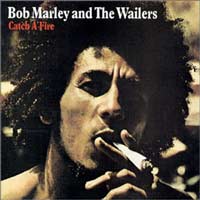 Die dickste TĂĽte hat natĂĽrlich Good Old Bob!
Die dickste TĂĽte hat natĂĽrlich Good Old Bob!
(20.06.2016)

 Mehr ...
Mehr ...
Catch a Fire was the major label debut for Bob Marley and the Wailers, and it was an international success upon its release in 1973. Although Bob Marley may have been the main voice, every member of the Wailers made valuable contributions and they were never more united in their vision and sound. All the songs were originals, and the instrumentation was minimalistic in order to bring out the passionate, often politically charged lyrics. Much of the appeal of the album lies in its sincerity and sense of purpose -- these are streetwise yet disarmingly idealistic young men who look around themselves and believe they might help change the world through music. Marley sings about the current state of urban poverty ("Concrete Jungle") and connects the present to past injustices ("Slave Driver"), but he is a not a one-trick pony. He is a versatile songwriter who also excels at singing love songs such as his classic "Stir It Up." Peter Tosh sings the lead vocal on two of his own compositions -- his powerful presence and immense talent hint that he would eventually leave for his own successful solo career. More than anything else, however, this marks the emergence of Bob Marley and the international debut of reggae music. Marley would continue to achieve great critical and commercial success during the 1970s, but Catch a Fire is one of the finest reggae albums ever. This album is essential for any music collection.
(by Vik Iyengar, All Music Guide)
|
| Inga Rumpf: "Second-Hand-Mädchen" (Philips, Okt. 1975) |
 Ingas erstes Soloalbum, aufgenommen noch zu Atlantis-Zeiten,
von denen auch alle Musiker hier mitspielen, ergänzt durch einen
fettes Bläsersatz, arrangiert von Peter Herbolzheimer und
auch ein paar abgefahrenen Mundharmonikatönen des legendären
Toots Thielemans aus Belgien. Die schnodderigen deutschen Texte
hatten ihr den Vorwurf eingebracht, auf den "Udo-Lindenberg-Zug"
aufzuspringen. Die nächsten Soloalben waren dann auch wieder auf
Englisch. Trotzdem: Coole Kippe, colle Platte, wenn auch nicht der groĂźe
Erfolg ...
Ingas erstes Soloalbum, aufgenommen noch zu Atlantis-Zeiten,
von denen auch alle Musiker hier mitspielen, ergänzt durch einen
fettes Bläsersatz, arrangiert von Peter Herbolzheimer und
auch ein paar abgefahrenen Mundharmonikatönen des legendären
Toots Thielemans aus Belgien. Die schnodderigen deutschen Texte
hatten ihr den Vorwurf eingebracht, auf den "Udo-Lindenberg-Zug"
aufzuspringen. Die nächsten Soloalben waren dann auch wieder auf
Englisch. Trotzdem: Coole Kippe, colle Platte, wenn auch nicht der groĂźe
Erfolg ...
(19.06.2016) |
| Rivulets: "I Remember Everything" (JellyFant, Sept. 2014) |
 Das Label JellyFant aus Oberhausen ist erst seit kurzem auf
meinem Radar, Dank Björn Kleinhenz.
Dort fiel mir auch diese Band auf, die ich bisher nicht kannte. Da hatte
natĂĽrlich auch mit dem wunderbaren Cover zu tun, das auch noch auf
meine Seite "Cover Girls"
passt. Sparsamer und wunderschöner Singer/Songwriter-Folkrock von
einem gewissen Nathan Amundson aus Denver, Colorado. Erinnert mich
ein wenig an Galaxy 500 bzw. Damon
& Naomi - oder an den späten Jason Molina (Magnolia
Electric Co.).
Das Label JellyFant aus Oberhausen ist erst seit kurzem auf
meinem Radar, Dank Björn Kleinhenz.
Dort fiel mir auch diese Band auf, die ich bisher nicht kannte. Da hatte
natĂĽrlich auch mit dem wunderbaren Cover zu tun, das auch noch auf
meine Seite "Cover Girls"
passt. Sparsamer und wunderschöner Singer/Songwriter-Folkrock von
einem gewissen Nathan Amundson aus Denver, Colorado. Erinnert mich
ein wenig an Galaxy 500 bzw. Damon
& Naomi - oder an den späten Jason Molina (Magnolia
Electric Co.).
(31.12.2015)

 Mehr ...
Mehr ...
Im Rahmen einer neuen Kooperation der Labels JellyFant und popup-records bildet »I Remember Everything« den Anfang einer vielversprechenden Serie. Somit ist das bereits hochgelobte Werk »Ein sicherer Kandidat für das Album des Jahres«. (Westzeit).
Die gefühlte Wahrheit: Rivulets ist der Act, der auf Festivals auf einer Nebenbühne spielt. Auftritt ca. 17 Uhr. Ein paar Leute haben sich gezielt zum Auftritt begeben, viele hören im Vorbeigehen, wie Nathan Amundson wahlweise in die Saiten seiner akustischen oder elektrischen Gitarre greift. Einige verlangsamen das Tempo, drehen sich mit Bier in der Hand zur Bühne, bleiben stehen, hören zu, und zum Ende der Show steht dort eine kleine Menge an Leuten, die, auch wenn sie Rivulets bis dato noch nicht kannten, Teile seiner Songs mitsingen und im Kopf mit nach Hause nehmen. Rivulets baut nach und nach Draht zum Hörer auf, er weckt und nährt den Instinkt der Verbundenheit und streut dafür hartnäckig repetitive Elemente.
"Are you ready now?", fragt der Mann aus Denver wieder und wieder im Opener "Reinforced/Delicate". Warum macht er das? Vielleicht weil mit "Into the night" eine der beiden Herzklappen von "I remember everything" folgt. Der Song, so lässt es sich jedenfalls interpretieren, erzählt von einer Person, die in Selbstmitleid badet, trinkt, und soziale Beziehungen unentwegt gegen die Wand fährt: "How long till you've had everyone?" Tristesse und Schönheit zugleich versprühend wäre es ein schmückender Song für jeden Road-Movie, dessen gedoppelte, dezent kanonisch angelegten Vocals den Hörer ruckzuck in den Chor der Melancholiker einschließt. "The clicking of the keys, a sound that keeps you company into the night."
Wie auch schon Strand Of Oaks mit "JM" auf "Heal" huldigt Amundson auf seinem fünften Album als Rivulets dem zu früh verstorbenen Jason Molina, der ein wichtiger Einfluss für "I remember everything" gewesen sein muss. In "Ride on, Molina" drehen die Gitarrenfiguren viele Schleifen und Amundsons Textpartikel ebenso: "The muse don't care what chords you use / The time to burn is yours to choose." Mit fast acht Minuten geht das wohl als epischer Minimalismus durch. Oft dem Slowcore zugewandt, kann Amundson auch anders. Im nur gut einminütigen E-Akustik-Stück "Carry you" gesteht sich die Hauptfigur häufiges Scheitern ein, während "My favorite drug is sleep" seine Zuflucht in der Bettenburg sucht und dabei ein wenig so klingt, als würden Nick Drake und Elliott Smith den "Mellow gold"-Beck interpretieren.
Wir sind aber noch die zweite Herzklappe schuldig. Auch wenn sich "Is that all you've got" beste Mühe gibt, sticht dann doch nicht die Singer-Songwriter-Nummer mit Banjo-Begleitung im Lo-Fi-Gewand am eindringlichsten neben "Into the night" hervor. Zu großartig baut sich "Your own place to ruin" auf. Dabei dreht Amundson gegen Ende des Indie-Rock-Songs nur an ein paar Stellschrauben: Die Snare scheppert etwas mehr, der Griff in die Saiten wird ein Tick beherzter und der Gesang ein wenig intensiver, was der Kernfrage "Isn't it time you find your own place to ruin?" mehr und mehr Nachdruck verleiht. Das sind jene Zeilen, die man mit nach Hause nimmt und die morgen auf T-Shirts prangen.
PS: In puncto Cover des Jahres auch ziemlich weit vorne.
(Stephan Müller, www.plattentests.de)
I've known Nathan for many years and we've played shows and made records together, so I know his thing - hushed, reaching vocals weaving an often melancholic impression over sparse guitar and ambient backdrop. As the opening song ("Reinforced/Delicate") stumbles in, carrying that familiar weight, I thought I knew what was coming, but I was wrong. By the first two lines of "Into the Night", the second song, I had to sit down because if the rest of the record was going to be like this, I knew I wanted to be there with it. To my delight, it did not let up - every song a relentless epiphany, the ragged edge of emotional, even physical, abandon. Timeless songs like "My Favorite Drug is Sleep" and "I was Once a Handsome Man" careen into the more artful/obtuse textures even thru the sprawling electric tribute of "Ride on, Molina." This is what happens when someone with a truly unique vision sticks to their guns and proves it.
(Alan Sparhawk, Low)
|
| Michael Chapman: "Pleasures Of The Street" (Nova/Gama, 1975) |
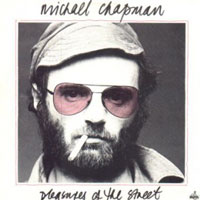 Ich habe in meiner Plattensammlung gleich drei Alben von Mr. Chapman gefunden,
die fĂĽr diese Seite in Frage kamen. Aber zusammen mit der Pilotenbrille
ist das hier natĂĽrlich ein echt cooler Smoker. "Pleasures
Of The Street" ist ein Livealbum des englischen Folk- und Rockgitarristen,
aufgenommen im Onkel Pö in Hamburg mit Keef Hartley
am Schlagzeug, Steffi Stefan (aus Udos Panikorchester) am Bass
und Achim Reichel an der zweiten Gitarre.
Ich habe in meiner Plattensammlung gleich drei Alben von Mr. Chapman gefunden,
die fĂĽr diese Seite in Frage kamen. Aber zusammen mit der Pilotenbrille
ist das hier natĂĽrlich ein echt cooler Smoker. "Pleasures
Of The Street" ist ein Livealbum des englischen Folk- und Rockgitarristen,
aufgenommen im Onkel Pö in Hamburg mit Keef Hartley
am Schlagzeug, Steffi Stefan (aus Udos Panikorchester) am Bass
und Achim Reichel an der zweiten Gitarre.
(05.07.2015) |
| Jim O'Rourke: "Simple Songs" (Drag City, Mai 2015) |
 Der Avantgarde-Gitarrist und zeitweise Sonic Youth-Bassist Jim
O'Rourke mit seinem ersten "normalen", songorientierten
Album seit vielen Jahren, aufgenommen in Japan (!) mit einer japanischen
Band. Von den Musikern ist mir - wenig ĂĽberraschend - keiner bekannt.
Der Avantgarde-Gitarrist und zeitweise Sonic Youth-Bassist Jim
O'Rourke mit seinem ersten "normalen", songorientierten
Album seit vielen Jahren, aufgenommen in Japan (!) mit einer japanischen
Band. Von den Musikern ist mir - wenig ĂĽberraschend - keiner bekannt.
(28.06.2015)

 Mehr ...
Mehr ...
Nach 14 Jahren meldet sich der großartige US-amerikanische Experimental-Musiker, Musikproduzent, Filmkomponist und Kurzfilmregisseur Jim O'Rourke endlich wieder mit einem Vocal-Album zurück!
Bei »Simple Songs« handelt es sich um mehr als nur einen ersten Release seit so und so vielen Jahren! Es ist ein unglaubliches Album, voller erstklassiger musikalischer Unterhaltung. Das mag daran liegen, dass Jim O'Rourke musikalisch genau weiß, was er will und wie er es erreicht. Zehn Jahre sind vergangen seit Jims Stimme von einem neuen Release ertönte, und es ist schwer zu glauben, dass bereits fast 14 Jahre seit dem Album »Insignificance« vergangen sind. Als Jim 2009 sein instrumentales Werk »The Visitors« vorstellte, welches stark an »Bad Timing« erinnerte, fragten sich viele Leute, wann es endlich wieder ein Album wie »Insignificance« geben würde.
»Simple Songs« klingt aufgrund der hohen Instrumenten-Dichte wie O'Rourke's eigene »Wall of Sound«. Die Musik wirkt wie unter Zwangsstörung komponiert, und die vielen Instrumente wurden größtenteils vom Schöpfer selbst in reinster Makellosigkeit eingespielt.
Dieses Werk ist Jims bisher wirklich größte Projektionsfläche für seinen Pop-Song Stil und wahrhaftig atemberaubend. »Simple Songs« wurde wieder und wieder überarbeitet und brauchte vom Beginn bis zum fertigen Mix fünf Jahre oder sogar mehr. Und wer das Album als musikalische Ausdruck O'Rourkes in seinen Kopf sickern lässt, wird feststellen, dass sich das Warten gelohnt hat. Jim hat das, was die Welt gerade dringend braucht!
|
| Bobby Hutcherson: "Total Eclipse" (Blue Note, 1968) |
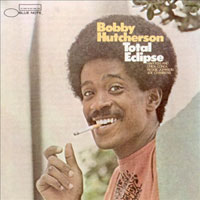 Definitiv ein cooler Raucher ist der Jazzvibraphonist Bobby Hutcherson
auf diesem Spätsechsiger-Album.
Definitiv ein cooler Raucher ist der Jazzvibraphonist Bobby Hutcherson
auf diesem Spätsechsiger-Album.
(31.05.2015)

 Mehr ...
Mehr ...
Total Eclipse was Bobby Hutcherson's first recording session with tenor saxophonist Harold Land, who became one of his major collaborators (and a quintet co-leader) during the late '60s. Land's rounded, echoing tone is a nice contrast for the coolly cerebral post-bop that fills Total Eclipse. Hutcherson contributes four of the five compositions (the other, "Matrix," is by pianist Chick Corea), and he's in a mood to intellectually challenge himself and the rest of the quintet, which also includes bassist Reggie Johnson and longtime drummer Joe Chambers. The results are full of the sort of skillful musicianship one would naturally expect of Hutcherson's '60s-era Blue Notes. Land's solo lines are fluid and lengthy, assimilating some of Coltrane's innovations while remaining accessibly soulful. Though they're all pretty strong, "Pompeian" is the most ambitious piece; it opens with a happy-go-lucky, waltz-time flute melody, and after a bit of foreboding, Hutcherson expands upon it with a tinkling bell solo. Toward the end of the piece, the whole group builds to a chaotic eruption, with Hutcherson switching to marimba (as he often did when he wanted a darker tone and high-tempo articulation); the pretty flute theme is then repeated as the dust settles and the piece ends. Overall, though, the album foreshadows Hutcherson's move away from his explicit avant-garde leanings and into a still-advanced but more structured modernist framework. For some reason, Total Eclipse was the only post-bop-styled album Hutcherson and Land recorded together that was released at the time; though they're all high-quality, this remains perhaps the best of the lot.
(by Steve Huey, All Music Guide)
|
| Locust Fudge: "Flush" (Glitterhouse, Aug. 1993) |
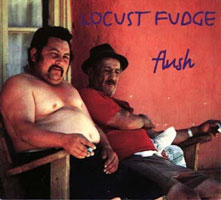 Bei den beiden Rauchern auf der Cover handelt es wohl nicht um die KĂĽnstler
Dirk Dresselhaus (AKA Schneider) von den Hip Young
Things und Christopher Uhe (AKA Krite) von den
Speedniggs , die hier unter
dem kruden Bandnamen Locust Fudge (Heuschrecken Lutschbonbon!)
agieren ...
Bei den beiden Rauchern auf der Cover handelt es wohl nicht um die KĂĽnstler
Dirk Dresselhaus (AKA Schneider) von den Hip Young
Things und Christopher Uhe (AKA Krite) von den
Speedniggs , die hier unter
dem kruden Bandnamen Locust Fudge (Heuschrecken Lutschbonbon!)
agieren ...
(28.12.2014)

 Mehr ...
Mehr ...
1991 gründeten Schneider a. k.a. Dirk Dresselhaus (Schneider TM, Hip Young Things) und Krite a. k.a. Christopher Uhe (Speed Niggs, Sharon Stoned, Floor) Locust Fudge. Nach diversen gemeinsamen Konzerten ihrer verschiedenen Bands taten sie sich zusammen, um die Bielefelder Bevölkerung in der Fussgängerzone mit ihren Hits in akustischer Version zu beglücken. Davon hörte Reinhard Holstein, seineszeichens Chef von Glitterhouse Records, dem Label, das zu der Zeit noch für die europäischen Releases des Sub Pop Labels verantworlich war.
Holstein wollte ein Album für sein Label und er bekam es: »Flush« wurde 1993 veröffentlicht. Das Album enthält je vier Songs, die Schneider vorher mit den Hip Young Things sowie Krite mit den Speed Niggs aufgenommen haben. Daneben gibt es noch Coverversionen von The Notwist, Lou Reed und Neil Young. Nach diversen Konzerten als Duo entschieden sich die beiden ihren Sound zu verändern. Weg vom fast klassischen Singer-Songwriter-Stil hin zu etwas, das sie »Lofi-Glam-Folk« nannten. Das Ergebnis nannte sich »Royal Flush« und erschien 1995 ebenfalls auf Glitterhouse Records.
Nachdem 1996 noch die EP »Business Express« erschien, nahmen sich die beiden eine Auszeit von dem Projekt, ohne sich je aufzulösen. Ein letztes musikalisches Lebenszeichen gab es 2004 mit einem Beitrag zu dem The Fall Tribute Sampler »Perverted by Mark E.«. Im Dezember 2014 erscheinen »Flush« und »Royal Flush« nun endlich als gemeinsame Doppel-LP auf dem Bielefelder Label Kapitän Platte.
Wiederveröffentlichung der ersten beiden Alben dieses von uns höchst geschätzten Duos auf dem Bielefelder Label Kapitän Platte. Erstmalig auf Vinyl, auf 500 Stck. limitiert, als Doppel-LP im Klappcover, mit haufenweise Linernotes plus Downloadcode. 1991 gründeten Schneider a.k.a. Dirk Dresselhaus (Schneider TM, Hip Young Things) und Krite a.k.a. Christopher Uhe (Speed Niggs, Sharon Stoned, Floor) Locust Fudge. Ihr Debüt “Flush“ erschien 1993 auf Glitterhouse. Vier Songs aus Schneiders Feder, vier aus Krites. Dazu Covers von The Notwist, Neil Young und Lou Reed. Alles im reduzierten klassischen Singer-/Songwriter- Stil - Schönklang mit Brüchen, mit Tiefe und Herzensbildung, changierend zwischen Unschuld und weltgebeutelter Expertise. So unfertig, unschuldig und bewusst unperfekt das Album klingen mag, „Flush“ ist ein Juwel, nicht weniger als das, ein Klassiker im Glitterhouse-Label-Katalog. 1995 kam „Royal Flush“ der inhaltlich nicht zwangsläufige Nachfolger. Schneider und Krite selbst meinten, ein lebensbejahendes Easy-Listening-Album aufzunehmen. Weit gefehlt. Das Album ist eher „eine wunderschöne Sammlung verpatzter Radio-Hits mit Tiefenschärfe“ wie es der damalige Infotext ausdrückte, „Lofi-Glam-Folk“ nannten sie das selbst. Keyboards und rumpelnde Beats halten Einzug, es wird verstohlen an Knöpfchen gedreht, das ist nie ungebrochen, da lauert immer irgendwo ein Kloß im Hals. Locust Fudge flirten mit dem Desaster, gehen lächelnd Risiken ein, nehmen vorweg, was Jahre später mal an Indie-Rock gut sein sollte, haben Songs, für die andere morden würden und Soundvorstellungen, für die es Phantasie und Weitblick braucht. „Cake“ z.B. oder „Racing Horse“ sind verflucht einnehmende Großtaten, die in einer besseren Welt seit 20 Jahren die Charts dominieren würden. Eine schändlich übersehene bzw. fast vergessene Band, die nicht wieder in Vergessenheit geraten sollte. Bitte bevorraten Sie sich.
(rs, Glitterhouse)
|
| Locust Fudge: "Royal Flush" (Glitterhouse, Juni 1995) |
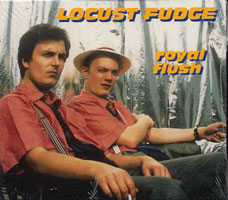 ... beim zweiten Album dagegen schon!
... beim zweiten Album dagegen schon!
(28.12.2014) |
| Marianne Faithfull: "Give My Love To London" (Naïve, Okt. 2015) |
 Im Unterschied zu Jackson Browne
kam diese Schallplatte nur mit zweimonatiger Verspätung
bei mir an. Welch besonderen Status diese Dame innerhalb der britischen
Popmusik hat wird vielleicht daran deutlich, wer hier alles mitkomponiert
oder mitgespielt hat: Nick Cave, Steve Earle, Ana Calvi, Roger Waters,
Ed Harcourt, Brian Eno und noch ein paar mehr. Trotzdem ist das ganz alleine
die Party der Faithfull (so spricht man echte Diven an:
die Monroe, die Callas, etc).
Im Unterschied zu Jackson Browne
kam diese Schallplatte nur mit zweimonatiger Verspätung
bei mir an. Welch besonderen Status diese Dame innerhalb der britischen
Popmusik hat wird vielleicht daran deutlich, wer hier alles mitkomponiert
oder mitgespielt hat: Nick Cave, Steve Earle, Ana Calvi, Roger Waters,
Ed Harcourt, Brian Eno und noch ein paar mehr. Trotzdem ist das ganz alleine
die Party der Faithfull (so spricht man echte Diven an:
die Monroe, die Callas, etc).
(24.12.2014)

 Mehr ...
Mehr ...
Goldenes Karrierejubiläum: 20. Album der englischen Sängerin; feat. Brian Eno, Ed Harcourt.
Es ist kaum zu glauben, aber 2014 kann Marianne Faithfull auf eine 50-jährige Schallplattenkarriere zurückblicken. Seit sie 1964 in London als 17-Jährige mit dem Jagger/Richards-Songs »As Tears Go By« zum Top-10-Star avancierte, verbrachte sie ein überaus ereignisreiches Leben und produzierte ein großes und abwechslungsreiches musikalisches Werk.
Zum Jubiläum erscheint neben einem luxuriösen Fotobuch (»Marianne Faithfull: A Life On Record«) das Album »Give My Love To London«.
Produziert von Rob Ellis und Dimitri Tikovoi und gemischt von Flood, beeindruckt ihr 20. Studioalbum unter anderem mit einer illustren Schar an Gästen wie Adrian Utley (Portishead), Brian Eno, Ed Harcourt sowie Warren Ellis und Jim Sclavunos von den Bad Seeds. Als Songwriter und Mitverschwörer waren Nick Cave, Roger Waters, Steve Earle, Tom McRae und Anna Calvi mit dabei - wobei die Mehrzahl der Texte von Faithfull stammt.
»Give My Love To London« ist erneut ein breit gefächertes und eklektisches Angebot einer ewig zeitlosen und großen Künstlerin.
... ist ›Give My Love To London‹ damit ein grandios intensives Album, eines dieser Leuchtturmwerke künstlerischer Unmittelbarkeit. Es fügt sich in die Reihe der Meisterstücke ein, welche Marianne Faithfull als schillernde Figur der Pop History geschaffen hat ...
(stereoplay, November 2014)
›Give My Love ...‹ ist ein exzellenter Querschnitt ihres Stil-Kaleidoskops, mit düster-getragenen, stil- und machtvollen Piano-Balladen ... und rau treibendem ... Rock.
(Audio, November 2014)
|
| Donald Fagen: "The Nightfly" (Warner, Nov. 1982) |
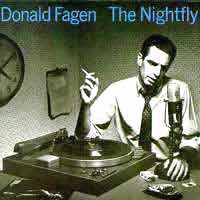 Das erste Soloalbum des Meisters war im Prinzip eine FortfĂĽhrung
von Steely Dan, nur eben ohne Walter
Becker. Das Cover gehört natürlich auf diese Seite!.
Das erste Soloalbum des Meisters war im Prinzip eine FortfĂĽhrung
von Steely Dan, nur eben ohne Walter
Becker. Das Cover gehört natürlich auf diese Seite!.
(31.10.2014)

 Mehr ...
Mehr ...
Donald Fagen's 1982 solo debut extends the sleek, smart pop craft of his work with Steely Dan into the realm of the concept album, taking the Dan's penchant for intricate plotting, evocative narrative voices, and allusive imagery to the logical next step. Fagen's connective thread is futurist nostalgia for the "New Frontier" as anticipated from the prosperous vantage point of late-'50s America. He romanticises a brave new world of technology in the sultry diorama of "I.G.Y.", celebrating the coming glories of the Atomic Age. He then filters that view through his own suburban adolescence--a would-be seduction in a fall-out shelter, the siren song of a graveyard-shift jazz DJ, a not-quite-hard-boiled noir adventure ("The Goodbye Look") that borrows its title from an early '60s Ross MacDonald mystery. Song for song, the set's a stunner and stands apart from Steely Dan thanks to a unique, poignant romanticism embodied in Fagen's yearning "Maxine" and a creamy update of Dion & the Belmonts' "Ruby Baby".
(Sam Sutherland)
|
| John Stewart: "Fire In The Wind" (RSO, 1977) |
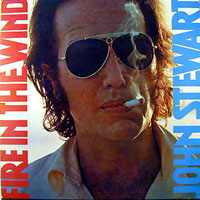 Singer/Songwriter John Stewart (Ex-Kingston Trio, Hitlieferant fĂĽr die Monkees
u.a. ) macht hier einen auf wirklich coolen Raucher. Ein gutes
Album - wenn man Singer/Songwriter-Pop-Rock aus Kalifornien mit Nashville-Zutaten
mag. Ich mag's irgendwie.
Singer/Songwriter John Stewart (Ex-Kingston Trio, Hitlieferant fĂĽr die Monkees
u.a. ) macht hier einen auf wirklich coolen Raucher. Ein gutes
Album - wenn man Singer/Songwriter-Pop-Rock aus Kalifornien mit Nashville-Zutaten
mag. Ich mag's irgendwie.
(12.10.2014) |
| Roy Harper: "Flat Baroque And Berserk" (EMI/Harvest, 1970) |
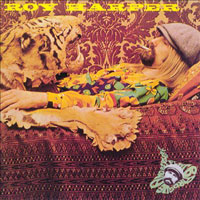 Harpers viertes Album und sein erstes bei Mutter EMI. Ein schönes
Klappcover mit Tigerfell und Kippe. Aufgenommen meist solo und akustisch
in den berĂĽhmten Abbey-Road-Studios. Teilweise haben die StĂĽcke
längere Ansagen und auch Applaus, anscheinend war da wohl Publikum
im Studio bzw. es ist ein kleiner Witz von Mr. Harper. Fast durchgängig
gibt es also guten Singer/Songwriter-Folk, aber am Ende wird mit UnterstĂĽtzung
der Band The Nice einmal kräftig gerockt. Ich schwöre:
meine einzige Platte, auf der Keith Emerson mitspielt!
Harpers viertes Album und sein erstes bei Mutter EMI. Ein schönes
Klappcover mit Tigerfell und Kippe. Aufgenommen meist solo und akustisch
in den berĂĽhmten Abbey-Road-Studios. Teilweise haben die StĂĽcke
längere Ansagen und auch Applaus, anscheinend war da wohl Publikum
im Studio bzw. es ist ein kleiner Witz von Mr. Harper. Fast durchgängig
gibt es also guten Singer/Songwriter-Folk, aber am Ende wird mit UnterstĂĽtzung
der Band The Nice einmal kräftig gerockt. Ich schwöre:
meine einzige Platte, auf der Keith Emerson mitspielt!
(23.02.2014)

 Mehr ...
Mehr ...
Roy Harper's fourth album found him in an acoustic folkie mode more often than not, though as usual (for circa late-'60s Harper) there were detours into pretty rocky items on occasion. It's not much of either a progression or a slide from the lyrically convoluted, somewhat but not incredibly melodic path he had established with his prior work. "I Hate the White Man," however, is certainly one of his most notable (and notorious) compositions, a spew of lilting verbiage that's hard to peg. It could be irony, it could be ironic self-hatred, it could be muddled reflections on the chaos that is the modern world, or it could be a combination of all of them. There are gentler items, sometimes with subdued harmony vocals and orchestration, that sound rather like Harper's most acerbic side sanded off with edges of Al Stewart, Donovan, or Tim Hardin; "Another Day" is the prettiest of those. The atypical "Hell's Angels," on the other hand, has a twisted, chunky rock feel rather like the solo work of another of producer Peter Jenner's clients, Syd Barrett.
(by Richie Unterberger, All Music Guide)
|
| "Nina Hagen Band" (Columbia, 1978) |
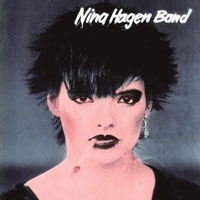 Wie konnte ich diese Platte nur vergessen? Nina Hagen war auch
definitiv cooler als das Mädel auf Freddie Hubbards
Plattenhülle. Als Persönlichkeit kann man zu Nina
Hagen stehen wie man mag, auch ich bin definitiv kein Fan, aber diese
Album zusammen mit den Herren eingespielt, die danach als Spliff
noch sehr erfolgreich wurden, war schon ziemlich amtlich.
Wie konnte ich diese Platte nur vergessen? Nina Hagen war auch
definitiv cooler als das Mädel auf Freddie Hubbards
Plattenhülle. Als Persönlichkeit kann man zu Nina
Hagen stehen wie man mag, auch ich bin definitiv kein Fan, aber diese
Album zusammen mit den Herren eingespielt, die danach als Spliff
noch sehr erfolgreich wurden, war schon ziemlich amtlich.
(28.01.2013) |
| Freddie Hubbard: "Skagly" (Columbia, Juni 1980) |
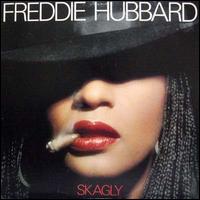 Freddie Hubbard, einer der weltbesten Jazztrompeter, ist hier natĂĽrlich
nicht auf dem Cover abgebildet, sondern ein unbekanntes Fotomodell, das
da so genĂĽĂźlich (?) am Zigarillo (?) zieht. "Skagly"
war Freddies letztes Album fĂĽr CBS und bietet guten, wenn auch nicht
außergewöhnlichen Mainstream-Hardbop mit ein paar moderneren
Elementen (d.h. meist Fender Rhodes statt FlĂĽgel und etwas Funk in
der Rhythmusgruppe). Ausnahmsweise war auch mal die feste Band statt Allstars
im Studio zu hören, von denen ich nur den unterschätzen Hadley
Caliman (Saxophon und Flöte) und Bassist Larry Klein,
später ein bekannter Produzent u.a. für seine zweitweilige Ehefrau
Joni Mitchell, erwähnen möchte.
Freddie Hubbard, einer der weltbesten Jazztrompeter, ist hier natĂĽrlich
nicht auf dem Cover abgebildet, sondern ein unbekanntes Fotomodell, das
da so genĂĽĂźlich (?) am Zigarillo (?) zieht. "Skagly"
war Freddies letztes Album fĂĽr CBS und bietet guten, wenn auch nicht
außergewöhnlichen Mainstream-Hardbop mit ein paar moderneren
Elementen (d.h. meist Fender Rhodes statt FlĂĽgel und etwas Funk in
der Rhythmusgruppe). Ausnahmsweise war auch mal die feste Band statt Allstars
im Studio zu hören, von denen ich nur den unterschätzen Hadley
Caliman (Saxophon und Flöte) und Bassist Larry Klein,
später ein bekannter Produzent u.a. für seine zweitweilige Ehefrau
Joni Mitchell, erwähnen möchte.
(26.01.2013)

 Mehr ...
Mehr ...
In general Freddie Hubbard's Columbia recordings can be skipped by serious jazz fans because, with the exception of Super Blue and to a lesser extent this album, they are overtly commercial and rather insincere efforts. This particular record at least uses the trumpeter's regular quintet of the period (with Hadley Caliman on tenor and flute, the up-and-coming keyboardist Billy Childs, bassist Larry Klein and drummer Carl Burnett) although the title cut has three guests (including keyboardist George Duke) whose role seemed to be to make the music more funky. With the exception of the standard "Theme from Summer of '42," none of the other songs (all group originals) caught on but Hubbard takes some good solos during these modern mainstream performances.
(by Scott Yanow, All Music Guide)
|
| Elvin Jones and Richard Davis: "Heavy Sounds" (Impulse!, 1968) |
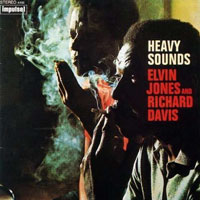 Jazztrommlerlegende Elvin Jones muĂź man eigentlich nicht
weiter vorstellen. Ich sag nur: "A
Love Supreme". Aber auch sein Partner, Bassist Richard Davis,
ist kein Unbekannter, u.a. einer der beteiligten Jazzer, die Van Morrisons
"Astral Weeks" zu einem
musikalischen Meilenstein gemacht haben: Heavy sounds by heavy smokers?
Jazztrommlerlegende Elvin Jones muĂź man eigentlich nicht
weiter vorstellen. Ich sag nur: "A
Love Supreme". Aber auch sein Partner, Bassist Richard Davis,
ist kein Unbekannter, u.a. einer der beteiligten Jazzer, die Van Morrisons
"Astral Weeks" zu einem
musikalischen Meilenstein gemacht haben: Heavy sounds by heavy smokers?
(04.08.2012)

 Mehr ...
Mehr ...
For this CD reissue, an Impulse! session co-led by drummer Elvin Jones and bassist Richard Davis was brought back by MCA. Tenor saxophonist Frank Foster and pianist Billy Green complete the quartet, which performs an erratic but generally interesting set of music including "Shiny Stockings," Foster's funky "Raunchy Rita," and "Elvin's Guitar Blues"; the latter briefly features Jones making his first and only appearance on guitar. The music is essentially advanced hard bop but is not all that essential.
(by Scott Yanow, All Music Guide)
|
| Art Farmer: "Crawl Space" (CTI, 1977) |
 Eine der besseren CTI-Platten von einem der besten FlĂĽgelhornspieler weit
und breit. Vier lange & relaxte Nummern, eingespielt mit den allerbesten
Jazzern: Jeremy Steig (Flöte), Steve Gadd (Schlagzeug),
Will Lee & George Mraz (Bass), Dave Grusin (Tasten)
und Eric Gale (Gitarre).
Eine der besseren CTI-Platten von einem der besten FlĂĽgelhornspieler weit
und breit. Vier lange & relaxte Nummern, eingespielt mit den allerbesten
Jazzern: Jeremy Steig (Flöte), Steve Gadd (Schlagzeug),
Will Lee & George Mraz (Bass), Dave Grusin (Tasten)
und Eric Gale (Gitarre).
(04.12.2011) |
| "Mike Finnigan" (Warner, 1976) |
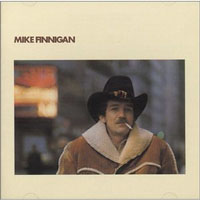 Ein gefragter Studio-Keyboarder (Jimi Hendrix,
Maria Muldaur, Dave Mason, Crosby,
Stills & Nash, etc.) mit einer seiner wenigen Veröffentlichungen
unter eigenem Namen. Stilistisch breit aufgestellt (Blues, Country, Gospel,
Jazz, ...) mit Liedern der unterschiedlichsten Autoren (Allen Toussaint,
Jesse Winchester, Billy Joel, ...). So was kann spannend
sein, aber auch völliger Murx, wenn überhaupt kein roter Faden
zu finden wäre, der alles zusammenhält. Bei vielen Musikern
aus der zweiten Reihe, die mal in's Rampenlicht dĂĽrfen, ist genau
das das Problem, aber Mike Finnigan hat eine wirklich tolle Platte gemacht,
auch wenn sie damals bei der Veröffentlichung sicherlich kein großer
Erfolg wurde.
Ein gefragter Studio-Keyboarder (Jimi Hendrix,
Maria Muldaur, Dave Mason, Crosby,
Stills & Nash, etc.) mit einer seiner wenigen Veröffentlichungen
unter eigenem Namen. Stilistisch breit aufgestellt (Blues, Country, Gospel,
Jazz, ...) mit Liedern der unterschiedlichsten Autoren (Allen Toussaint,
Jesse Winchester, Billy Joel, ...). So was kann spannend
sein, aber auch völliger Murx, wenn überhaupt kein roter Faden
zu finden wäre, der alles zusammenhält. Bei vielen Musikern
aus der zweiten Reihe, die mal in's Rampenlicht dĂĽrfen, ist genau
das das Problem, aber Mike Finnigan hat eine wirklich tolle Platte gemacht,
auch wenn sie damals bei der Veröffentlichung sicherlich kein großer
Erfolg wurde.
Vier Dinge halten alles zusammen: zum einen natĂĽrlich das tolle Orgelspiel
von Finnigan (das wuĂźte ich ja schon von den Platten der o.g. KĂĽnstler),
dann die gute Band (ich sag nur: Muscle Shoals!), dann die doch
sehr gut zusammenpassenden Lieder aus den unterschiedlichen Genres (eine
Dixieland-Nummer nach Billy Joels "New York State Of Mind"!),
vor allem aber die ĂĽberraschend gute Stimme unseres Protagonisten!
(09.06.2011) |
| Tim Rose: "Tim Rose (Morning Dew)" (Columbia, 1967) |
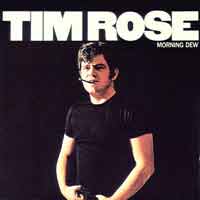 Kleiner Quiz: Ein amerikanischer Sänger, Gitarrist und Songschreiber
aus den späten 60ern, angesiedelt im Grenzbereich zwischen Rock,
Folk und Jazz, ohne den ganz groĂźen kommerziellen
Erfolg, mit dem Vornamen Tim: da fällt Kennern der
Materie als dritter nach Tim Buckley
und Tim Hardin (deren Rangfolge
ist sicherlich Geschmackssache!) vielleicht noch Tim Rose ein,
der ehemalige Gesangspartner von Cass Elliott, bevor diese mit
den Mamas & Papas bekannt wurde. Obwohl ich ihn in allen drei
Kategorien (also Gesang, Gitarre und Songwriting) für schwächer
als die anderen beiden Tims halte, ist sein DebĂĽtalbum durchaus gelungen,
was aber hauptsächlich an drei Coversongs liegt: da wäre zuerst
"Morning Dew" von der obskuren kanadischen Folksängerin
Bonnie Dobson zu nennen. Leider wird immer wieder behauptet, das
Tim Rose (Co-)Autor des Liedes wäre, aber er hält sich
im Prinzip an die erste veröffentlichte Version des Liedes von Fred
Neil aus dem Jahre 1964 (von dessen DebĂĽtabum "Tear Down
The Walls"), hatte aber wohl als erster einen kleineren Erfolg mit
der Nummer und viele Bands zu weiteren Versionen inspiriert (u.a. Jeff
Beck und die Grateful Dead!) . Im
Jahr 1966, also noch vor Jimi Hendrix,
aber ebenfalls anscheinend nicht als Erster (diese Ehre
gebührt einer Garagenband, deren Name mir gerade nicht einfällt),
brachte er "Hey Joe" als Single heraus. Immerhin
soll aber seine sehr schöne Version Chas Chandler darauf gebracht
haben, von diesem Lied mit Jimi
die ultimative Version aufzunehmen. Gut gefällt mir dann noch das
Anti-Kriegslied "Come Away Melinda", das ich bisher
nur von Uriah Heep kannte, deren Musik mich aber ansonsten recht
wenig interessiert, weshalb ich auch gar keinen Ehrgeiz habe herauszubekommen,
ob Tims Version denn nun wenigstens besser ist als die der Heeps.
Kleiner Quiz: Ein amerikanischer Sänger, Gitarrist und Songschreiber
aus den späten 60ern, angesiedelt im Grenzbereich zwischen Rock,
Folk und Jazz, ohne den ganz groĂźen kommerziellen
Erfolg, mit dem Vornamen Tim: da fällt Kennern der
Materie als dritter nach Tim Buckley
und Tim Hardin (deren Rangfolge
ist sicherlich Geschmackssache!) vielleicht noch Tim Rose ein,
der ehemalige Gesangspartner von Cass Elliott, bevor diese mit
den Mamas & Papas bekannt wurde. Obwohl ich ihn in allen drei
Kategorien (also Gesang, Gitarre und Songwriting) für schwächer
als die anderen beiden Tims halte, ist sein DebĂĽtalbum durchaus gelungen,
was aber hauptsächlich an drei Coversongs liegt: da wäre zuerst
"Morning Dew" von der obskuren kanadischen Folksängerin
Bonnie Dobson zu nennen. Leider wird immer wieder behauptet, das
Tim Rose (Co-)Autor des Liedes wäre, aber er hält sich
im Prinzip an die erste veröffentlichte Version des Liedes von Fred
Neil aus dem Jahre 1964 (von dessen DebĂĽtabum "Tear Down
The Walls"), hatte aber wohl als erster einen kleineren Erfolg mit
der Nummer und viele Bands zu weiteren Versionen inspiriert (u.a. Jeff
Beck und die Grateful Dead!) . Im
Jahr 1966, also noch vor Jimi Hendrix,
aber ebenfalls anscheinend nicht als Erster (diese Ehre
gebührt einer Garagenband, deren Name mir gerade nicht einfällt),
brachte er "Hey Joe" als Single heraus. Immerhin
soll aber seine sehr schöne Version Chas Chandler darauf gebracht
haben, von diesem Lied mit Jimi
die ultimative Version aufzunehmen. Gut gefällt mir dann noch das
Anti-Kriegslied "Come Away Melinda", das ich bisher
nur von Uriah Heep kannte, deren Musik mich aber ansonsten recht
wenig interessiert, weshalb ich auch gar keinen Ehrgeiz habe herauszubekommen,
ob Tims Version denn nun wenigstens besser ist als die der Heeps.
Trotz dieses ganzen Gemeckeres bleibt "Tim Rose" (oder "Morning
Dew", wie das Album ab 1968, nach jenem Minihit, hieĂź) ein
gutes Album.
(15.04.2010)

 Mehr ...
Mehr ...
Rose's self-titled debut was a fairly strong singer-songwriter set, divided about equally between originals and imaginative covers, showing strong blues and folk leanings as well as forays into orchestrated pop-rock. Includes "Morning Dew" and "Hey Joe."
(by Richie Unterberger, All Music Guide)
|
| Status Quo: "Ma Kelly's Greasy Spoon" (Pye, Sept. 1970) |
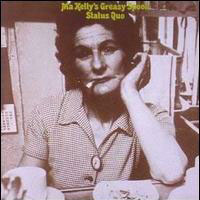 Nicht unbedingt meine Lieblinxplatte, aber als Teenie in den frĂĽhen
70ern fand ich Platte und Band eigentlich ganz gut. Auf jeden Fall hatten
sie davor nur unbedeutenden Pop produziert ("Pictures Of Matchstick
Man"), danach mit "Dog Of Two Heads" und "Piledriver"
noch zwei fĂĽr meine Ohren ordentliche Alben und anschliessend eigentlich
nur noch Schrott ...
Nicht unbedingt meine Lieblinxplatte, aber als Teenie in den frĂĽhen
70ern fand ich Platte und Band eigentlich ganz gut. Auf jeden Fall hatten
sie davor nur unbedeutenden Pop produziert ("Pictures Of Matchstick
Man"), danach mit "Dog Of Two Heads" und "Piledriver"
noch zwei fĂĽr meine Ohren ordentliche Alben und anschliessend eigentlich
nur noch Schrott ...
(26.02.2010)

 Mehr ...
Mehr ...
Woe betide the psychedelic groover who picked up the third album by Status Quo, dreaming of further picturesque matchstick messages! A mere three hits in a long three years had completely exhausted the bandmembers' patience with the whimsy of yore, and their ears had long since turned in other directions. It was the age, after all, of Canned Heat's relentless boogie and Black Sabbath's blistered blues, and when the Quo's first new single of 1970, the lazy throb of "Down the Dustpipe," proved that the record-buying public wasn't averse to a bit more down-home rocking, their future course was set. Ma Kelly's Greasy Spoon allies one of the most evocative titles in rock album history to one of the most familiar sights in a rock band's iconography, the cheap roadside café — crusty ketchup, leafy tea, an overflowing ashtray, and Ma Kelly herself, cigarette clenched between unsmiling lips and a face that has seen it all and didn't like any of it. Neither do the album's contents disturb her glowering visage. From the opening trundle of "Spinning Wheel Blues" and onto the closing, lurching medley of "Is It Really Me"/"Gotta Go Home," the most underrated disc in Status Quo's entire early catalog eschewed the slightest nod in the direction of the band's past — even "Dustpipe" didn't make the cut. (It has since been incorporated among the four bonus tracks appending the album's 1998 remastering as have "In My Chair", "Gerdundula" and an alternate version of "Junior's Wailing") But six years on, when recording their live album, the Quo were still dipping back to "Junior's Wailing," the midpoint in the greasy spoon experience, and an expressively rocking archetype for all they would later accomplish. The dark shuffle of "Lazy Poker Blues," too, unleashed specters that the band would be referencing in future days, including the boogie piano that made 1974's "Break the Rules" seem such a blast from the past. Compared to the albums that would follow, Ma Kelly is revealed as little more than a tentative blueprint for the Quo's new direction. At the time, however, it was a spellbinding shock, perhaps the last one that the Quo ever delivered. You should remember that when you play it.
(by Dave Thompson, All Music Guide)
|
| Johnny Hartman: "I Just Dropped By To Say Hello" (Impulse!, 1964) |
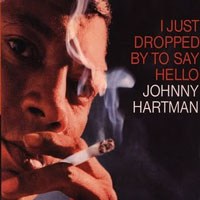 Einer der wenigen Sänger auf dem Impulse-Label mit
einem wunderbaren Balladen-Album. Es gibt sogar vom März des gleichen
Jahres noch eine Duett-Platte mit John Coltrane, die ich aber nur
in AuszĂĽgen von einem Sampler kenne. Begleitet wird Hartman hier
von den BrĂĽdern Hank Jones und Elvin Jones an Piano
bzw. Schlagzeug. Dazu kommen der Bassist Milt Hinton und bei einigen
Titeln Tenorsaxofonist Illinois Jacquet und die legendären
Gitarristen Kenny Burrell und Jim Hall. Wunderbare, schöne
Musik.
Einer der wenigen Sänger auf dem Impulse-Label mit
einem wunderbaren Balladen-Album. Es gibt sogar vom März des gleichen
Jahres noch eine Duett-Platte mit John Coltrane, die ich aber nur
in AuszĂĽgen von einem Sampler kenne. Begleitet wird Hartman hier
von den BrĂĽdern Hank Jones und Elvin Jones an Piano
bzw. Schlagzeug. Dazu kommen der Bassist Milt Hinton und bei einigen
Titeln Tenorsaxofonist Illinois Jacquet und die legendären
Gitarristen Kenny Burrell und Jim Hall. Wunderbare, schöne
Musik.
(31.01.2010)

 Mehr ...
Mehr ...
The second Impulse! session for ballad singer Johnny Hartman followed his classic collaboration with John Coltrane. Hartman is heard in peak form throughout these 11 pieces, which include "In the Wee Small Hours of the Morning," "Sleepin' Bee," "Stairway to the Stars," and even "Charade." Tenor saxophonist Illinois Jacquet is on five of the songs, guitarists Kenny Burrell and Jim Hall help out on a few tunes, and Hartman is consistently accompanied by pianist Hank Jones, bassist Milt Hinton, and drummer Elvin Jones. This is one of his finest recordings.
(by Scott Yanow, All Music Guide)
|
| Dinosaur Jr: "Green Mind" (Blanco Y Negro, Feb. 1991) |
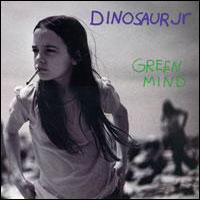 Das erste Dinosaur-Album bei groĂźer Plattenfirma (Blanco Y Negro
ist bzw. war das Sublabel von Warner für die etwas schrägeren
Töne, z.B. von The Jesus And
Mary Chain), das damals bei den Kritikern eher schlecht wegkam und
auch von mir nicht wirklich mit Geduld gehört wurde. Jetzt habe ich
es bei diesem nervigen Hai-Vieh-Disskaunter fĂĽr schlappe 4,44€
gefunden und finde es eigentlich gar nicht so schlecht. Damals ohne festen
Bassisten und dem "indisponierten" Murph nur auf drei
Liedern am Schlagzeug zu hören, ist das mehr oder weniger ein J
Mascis-Soloalbum, der im Übrigen selber einen ausgezeichneten
Trommler abgibt! Zweimal gibt es sogar putzige Flötentöne von
einem Mellotron im Stile von "Stairway To Heaven". Passt eigentlich
nicht, ist aber trotzdem schön.
Das erste Dinosaur-Album bei groĂźer Plattenfirma (Blanco Y Negro
ist bzw. war das Sublabel von Warner für die etwas schrägeren
Töne, z.B. von The Jesus And
Mary Chain), das damals bei den Kritikern eher schlecht wegkam und
auch von mir nicht wirklich mit Geduld gehört wurde. Jetzt habe ich
es bei diesem nervigen Hai-Vieh-Disskaunter fĂĽr schlappe 4,44€
gefunden und finde es eigentlich gar nicht so schlecht. Damals ohne festen
Bassisten und dem "indisponierten" Murph nur auf drei
Liedern am Schlagzeug zu hören, ist das mehr oder weniger ein J
Mascis-Soloalbum, der im Übrigen selber einen ausgezeichneten
Trommler abgibt! Zweimal gibt es sogar putzige Flötentöne von
einem Mellotron im Stile von "Stairway To Heaven". Passt eigentlich
nicht, ist aber trotzdem schön.
(19.07.2009)

 Mehr ...
Mehr ...
After temporarily suspending the band, J Mascis first snuck out "The Wagon" as a Sub Pop single, then a little while later released the group's first major-label album, Green Mind. More of a solo project than a group effort — Lou Barlow was out and then some, Murph only drums on three tracks, a few guests pop up here and there — it's still a great album, recorded and performed with gusto. Such a judgment may seem strange given Mascis' legendary image as the überslacker, but clearly the man knows how to balance how to convey himself with getting the job done. "The Wagon" itself kicks off the album, an even quicker and nuttier sequel to the peerless "Freak Scene" — Don Fleming of Gumball fame adds some of the music and background vocals, but otherwise it's Mascis and Murph cranking it and having a blast. When Mascis goes into one of his patented over-the-top solos, it all feels just right — this is loud rock music for putting a smile on your face, not beating up people in a pit. The remainder of the album floats and rumbles along in its uniquely Dinosaur Jr. type of way, as apt to find poppy hooks, singalongs, and soft strumming as it is to blow out the Marshalls. Sublime moments include the contrast of sweet acoustic guitar and loud drums on "Blowing It," the fun thrash of "How'd You Pin That One on Me," and the Mellotron-as-flute-tinged stomp "Thumb." If nothing on the album is completely as freaked-out and over the top as "Don't" from Bug, it's still a fine translation of Mascis' art for the commercial big boys. The song titles alone sometime say it all — "Puke + Cry," "I Live for That Look," "Muck." Mascis throughout sounds like his usual self, cracked drawl ever as it was and shall be.
(by Ned Raggett, All Music Guide)
|
| Bobby Bland: "Dreamer" (ABC/Dunhill, 1974) |
 Der Mann gilt schon seit den 5oern als einer der besten Bluessänger.
Ich habe ihn erst kĂĽrzlich fĂĽr mich entdeckt, als ich im Internet
ĂĽber die Nummer "I Wouldn't Treat A Dog" gegoogelt habe,
die ich bislang nur in der Coverversion der Nighthawks
kannte und bin dabei eben auf diese Platte gestossen. Mit "Ain't No
Love In The Heart Of The City" gibt's sogar noch eine zweite bekannte
Nummer, die viele sicherlich von irgendwelchen Blues-Brothers-Imitatoren
von irgendwelchen Stadtfesten kennen.
Der Mann gilt schon seit den 5oern als einer der besten Bluessänger.
Ich habe ihn erst kĂĽrzlich fĂĽr mich entdeckt, als ich im Internet
ĂĽber die Nummer "I Wouldn't Treat A Dog" gegoogelt habe,
die ich bislang nur in der Coverversion der Nighthawks
kannte und bin dabei eben auf diese Platte gestossen. Mit "Ain't No
Love In The Heart Of The City" gibt's sogar noch eine zweite bekannte
Nummer, die viele sicherlich von irgendwelchen Blues-Brothers-Imitatoren
von irgendwelchen Stadtfesten kennen.
Die Band bringt diesen schönen Mitt70er-Sound, der noch ohne Digitalequipment
auskam, allerdings setzt Keyboarder Michael Omartian schon einen
monophonen ARP-Synthesizer ein, der aber nicht weiter stört. Die
Gitarrenfraktion ist exquisit besetzt (Larry Carlton, Dean Parks
und Ben Benay), ebenso die Rhythmusgruppe (Wilton Felder
von den Crusaders am Bass und Ed Greene am Schlagzeug)
(24.05.2006)

 Mehr ...
Mehr ...
|
Barri's slightly antiseptic production style and Michael Omartian's arrangements
weren't the equivalent of Joe Scott's immaculate collabrations with Bland,
but this 1974 album's "Ain't No Love in the Heart of the City"
and a meaty "I Wouldn't Treat a Dog (The Way You Treated Me)"
were both huge hits.
(by Bill Dahl, All
Music Guide)
|
|
| Charles Mingus: "The Black Saint And The Sinner Lady" (Impulse!, Okt. 1963) |
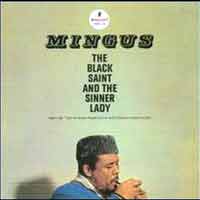 Ich bin war kein wirklicher Mingus-Kenner oder gar Jazz-Spezialist, doch
man kommt nicht daran vorbei festzustellen, dass Mingus einer der wichtigsten
Bassisten und Komponisten des Jazz ist. Bekanntester Mitspieler aus Sicht
eines "Jazz-AuĂźenseiters": Charlie Mariano, den es Ende
der 60er nach Europa zog, wo er z.B. mit der deutschen Gruppe Embryo
und dem United Jazz & Rock Ensemble zusammenarbeitete.
Ich bin war kein wirklicher Mingus-Kenner oder gar Jazz-Spezialist, doch
man kommt nicht daran vorbei festzustellen, dass Mingus einer der wichtigsten
Bassisten und Komponisten des Jazz ist. Bekanntester Mitspieler aus Sicht
eines "Jazz-AuĂźenseiters": Charlie Mariano, den es Ende
der 60er nach Europa zog, wo er z.B. mit der deutschen Gruppe Embryo
und dem United Jazz & Rock Ensemble zusammenarbeitete.

 Mehr ...
Mehr ...
| "This 1963 recording occupies a special place in Mingus's
work, his most brilliantly realized extended composition. The six-part suite
is a broad canvas for the bassist's tumultuous passions, ranging from islands
of serenity for solo guitar and piano to waves of contrapuntal conflict
and accelerating rhythms that pull the listener into the musical psychodrama.
It seems to mingle and transform both the heights and clichés of
jazz orchestration, from Mingus's master, Duke Ellington, to film noir soundtracks.
The result is a masterpiece of sounds and textures, from the astonishing
vocal effects of the plunger-muted trumpets and trombone (seeming to speak
messages just beyond the range of understanding) to the soaring romantic
alto of Charlie Mariano. Boiling beneath it all are the teeming, congested
rhythms of Mingus and drummer Dannie Richmond and the deep morass of tuba
and baritone saxophone. This is one of the greatest works in jazz composition,
and it's remarkable that Mingus dredged this much emotional power from a
group of just 11 musicians." (Stuart Broomer ) |
|
 Bereits das dritte tolle Album des Mannes, der uns allen den "Angel From
Montgomery" brachte. Wie immer dabei als Gitarrist Steve Goodman,
selber ein vorzĂĽglicher Songschreiber ("City Of New Orleans"),
dieses mal unterstĂĽtzt von der vorzĂĽglichen Nashville-Mafia
(Reggie Young, David Briggs, Kenny Malone, Grady Martin, u.a.),
als Produzent wie immer dabei Atlantic-Legende Arif Mardin.
Bereits das dritte tolle Album des Mannes, der uns allen den "Angel From
Montgomery" brachte. Wie immer dabei als Gitarrist Steve Goodman,
selber ein vorzĂĽglicher Songschreiber ("City Of New Orleans"),
dieses mal unterstĂĽtzt von der vorzĂĽglichen Nashville-Mafia
(Reggie Young, David Briggs, Kenny Malone, Grady Martin, u.a.),
als Produzent wie immer dabei Atlantic-Legende Arif Mardin.

 Mehr ...
Mehr ...
 Mehr ...
Mehr ...
 Diese Platte habe ich ja schon bei den Cover Girls
vorgestellt. Der Glimmstengel ist mir erst aufgefallen, als ich mir kĂĽrzlich die Vinylversion
dieses grandiosen Albums gegönnt habe!
Diese Platte habe ich ja schon bei den Cover Girls
vorgestellt. Der Glimmstengel ist mir erst aufgefallen, als ich mir kĂĽrzlich die Vinylversion
dieses grandiosen Albums gegönnt habe! Mehr ...
Mehr ...
 Drittes Soloalbum des ehemaligen Chefs von Television.
Drittes Soloalbum des ehemaligen Chefs von Television. Mehr ...
Mehr ...
 Wenn es eine coole Sängerin gibt ... dann ist das natürlich Rickie Lee Jones!
Wenn es eine coole Sängerin gibt ... dann ist das natürlich Rickie Lee Jones! Mehr ...
Mehr ...
 Das Debüt der Sängerin beim Indie-Label von Alan McGee.
Danach gab's noch drei Alben bei 4AD, bevor es ruhig um sie wurde.
Das Debüt der Sängerin beim Indie-Label von Alan McGee.
Danach gab's noch drei Alben bei 4AD, bevor es ruhig um sie wurde. Mehr ...
Mehr ...
 Und nochmals: Einer der besten amerikanischen Singer/Songwriter aus dem
Grenzbereich Folk/Country mit seinem titellosen, dritten Album.
Und nochmals: Einer der besten amerikanischen Singer/Songwriter aus dem
Grenzbereich Folk/Country mit seinem titellosen, dritten Album. Mehr ...
Mehr ...
 Einer der besten amerikanischen Singer/Songwriter aus dem Grenzbereich Folk/Country
mit seinem dritten Album.
Einer der besten amerikanischen Singer/Songwriter aus dem Grenzbereich Folk/Country
mit seinem dritten Album. Mehr ...
Mehr ...
 Wenn Tom Jobim nicht zu den Cool Smokers gehört,
wer dann? Auf diesem Album von Creed Taylors Smooth-Jazz-Label
wird der beste Komponist des Bossa Novas von den allerbesten Musikern
aus Brasilien und den USA begleitet. Den Titelsong kennt vielleicht der
eine oder andere in der Coverversion von Santana (!), zu finden
auf deren Meisterwerk "Caravanserai".
Wenn Tom Jobim nicht zu den Cool Smokers gehört,
wer dann? Auf diesem Album von Creed Taylors Smooth-Jazz-Label
wird der beste Komponist des Bossa Novas von den allerbesten Musikern
aus Brasilien und den USA begleitet. Den Titelsong kennt vielleicht der
eine oder andere in der Coverversion von Santana (!), zu finden
auf deren Meisterwerk "Caravanserai". Mehr ...
Mehr ...
 Als ich mir vor kurzem Ryans DebĂĽtalbum auf Vinyl zugelegt habe,
da ist mir auch endlich aufgefallen, dass auch er zu den Cool Smokers
gehört!
Als ich mir vor kurzem Ryans DebĂĽtalbum auf Vinyl zugelegt habe,
da ist mir auch endlich aufgefallen, dass auch er zu den Cool Smokers
gehört!  Mehr ...
Mehr ...
 Die dickste TĂĽte hat natĂĽrlich Good Old Bob!
Die dickste TĂĽte hat natĂĽrlich Good Old Bob! Mehr ...
Mehr ...
 Ingas erstes Soloalbum, aufgenommen noch zu Atlantis-Zeiten,
von denen auch alle Musiker hier mitspielen, ergänzt durch einen
fettes Bläsersatz, arrangiert von Peter Herbolzheimer und
auch ein paar abgefahrenen Mundharmonikatönen des legendären
Toots Thielemans aus Belgien. Die schnodderigen deutschen Texte
hatten ihr den Vorwurf eingebracht, auf den "Udo-Lindenberg-Zug"
aufzuspringen. Die nächsten Soloalben waren dann auch wieder auf
Englisch. Trotzdem: Coole Kippe, colle Platte, wenn auch nicht der groĂźe
Erfolg ...
Ingas erstes Soloalbum, aufgenommen noch zu Atlantis-Zeiten,
von denen auch alle Musiker hier mitspielen, ergänzt durch einen
fettes Bläsersatz, arrangiert von Peter Herbolzheimer und
auch ein paar abgefahrenen Mundharmonikatönen des legendären
Toots Thielemans aus Belgien. Die schnodderigen deutschen Texte
hatten ihr den Vorwurf eingebracht, auf den "Udo-Lindenberg-Zug"
aufzuspringen. Die nächsten Soloalben waren dann auch wieder auf
Englisch. Trotzdem: Coole Kippe, colle Platte, wenn auch nicht der groĂźe
Erfolg ... Das Label JellyFant aus Oberhausen ist erst seit kurzem auf
meinem Radar, Dank Björn Kleinhenz.
Dort fiel mir auch diese Band auf, die ich bisher nicht kannte. Da hatte
natĂĽrlich auch mit dem wunderbaren Cover zu tun, das auch noch auf
meine Seite "Cover Girls"
passt. Sparsamer und wunderschöner Singer/Songwriter-Folkrock von
einem gewissen Nathan Amundson aus Denver, Colorado. Erinnert mich
ein wenig an Galaxy 500 bzw. Damon
& Naomi - oder an den späten Jason Molina (Magnolia
Electric Co.).
Das Label JellyFant aus Oberhausen ist erst seit kurzem auf
meinem Radar, Dank Björn Kleinhenz.
Dort fiel mir auch diese Band auf, die ich bisher nicht kannte. Da hatte
natĂĽrlich auch mit dem wunderbaren Cover zu tun, das auch noch auf
meine Seite "Cover Girls"
passt. Sparsamer und wunderschöner Singer/Songwriter-Folkrock von
einem gewissen Nathan Amundson aus Denver, Colorado. Erinnert mich
ein wenig an Galaxy 500 bzw. Damon
& Naomi - oder an den späten Jason Molina (Magnolia
Electric Co.). Mehr ...
Mehr ...
 Ich habe in meiner Plattensammlung gleich drei Alben von Mr. Chapman gefunden,
die fĂĽr diese Seite in Frage kamen. Aber zusammen mit der Pilotenbrille
ist das hier natĂĽrlich ein echt cooler Smoker. "Pleasures
Of The Street" ist ein Livealbum des englischen Folk- und Rockgitarristen,
aufgenommen im Onkel Pö in Hamburg mit Keef Hartley
am Schlagzeug, Steffi Stefan (aus Udos Panikorchester) am Bass
und Achim Reichel an der zweiten Gitarre.
Ich habe in meiner Plattensammlung gleich drei Alben von Mr. Chapman gefunden,
die fĂĽr diese Seite in Frage kamen. Aber zusammen mit der Pilotenbrille
ist das hier natĂĽrlich ein echt cooler Smoker. "Pleasures
Of The Street" ist ein Livealbum des englischen Folk- und Rockgitarristen,
aufgenommen im Onkel Pö in Hamburg mit Keef Hartley
am Schlagzeug, Steffi Stefan (aus Udos Panikorchester) am Bass
und Achim Reichel an der zweiten Gitarre. Der Avantgarde-Gitarrist und zeitweise Sonic Youth-Bassist Jim
O'Rourke mit seinem ersten "normalen", songorientierten
Album seit vielen Jahren, aufgenommen in Japan (!) mit einer japanischen
Band. Von den Musikern ist mir - wenig ĂĽberraschend - keiner bekannt.
Der Avantgarde-Gitarrist und zeitweise Sonic Youth-Bassist Jim
O'Rourke mit seinem ersten "normalen", songorientierten
Album seit vielen Jahren, aufgenommen in Japan (!) mit einer japanischen
Band. Von den Musikern ist mir - wenig ĂĽberraschend - keiner bekannt. Mehr ...
Mehr ...
 Definitiv ein cooler Raucher ist der Jazzvibraphonist Bobby Hutcherson
auf diesem Spätsechsiger-Album.
Definitiv ein cooler Raucher ist der Jazzvibraphonist Bobby Hutcherson
auf diesem Spätsechsiger-Album. Mehr ...
Mehr ...
 Bei den beiden Rauchern auf der Cover handelt es wohl nicht um die KĂĽnstler
Dirk Dresselhaus (AKA Schneider) von den Hip Young
Things und Christopher Uhe (AKA Krite) von den
Speedniggs , die hier unter
dem kruden Bandnamen Locust Fudge (Heuschrecken Lutschbonbon!)
agieren ...
Bei den beiden Rauchern auf der Cover handelt es wohl nicht um die KĂĽnstler
Dirk Dresselhaus (AKA Schneider) von den Hip Young
Things und Christopher Uhe (AKA Krite) von den
Speedniggs , die hier unter
dem kruden Bandnamen Locust Fudge (Heuschrecken Lutschbonbon!)
agieren ...  Mehr ...
Mehr ...
 ... beim zweiten Album dagegen schon!
... beim zweiten Album dagegen schon! Im Unterschied zu Jackson Browne
kam diese Schallplatte nur mit zweimonatiger Verspätung
bei mir an. Welch besonderen Status diese Dame innerhalb der britischen
Popmusik hat wird vielleicht daran deutlich, wer hier alles mitkomponiert
oder mitgespielt hat: Nick Cave, Steve Earle, Ana Calvi, Roger Waters,
Ed Harcourt, Brian Eno und noch ein paar mehr. Trotzdem ist das ganz alleine
die Party der Faithfull (so spricht man echte Diven an:
die Monroe, die Callas, etc).
Im Unterschied zu Jackson Browne
kam diese Schallplatte nur mit zweimonatiger Verspätung
bei mir an. Welch besonderen Status diese Dame innerhalb der britischen
Popmusik hat wird vielleicht daran deutlich, wer hier alles mitkomponiert
oder mitgespielt hat: Nick Cave, Steve Earle, Ana Calvi, Roger Waters,
Ed Harcourt, Brian Eno und noch ein paar mehr. Trotzdem ist das ganz alleine
die Party der Faithfull (so spricht man echte Diven an:
die Monroe, die Callas, etc). Mehr ...
Mehr ...
 Das erste Soloalbum des Meisters war im Prinzip eine FortfĂĽhrung
von Steely Dan, nur eben ohne Walter
Becker. Das Cover gehört natürlich auf diese Seite!.
Das erste Soloalbum des Meisters war im Prinzip eine FortfĂĽhrung
von Steely Dan, nur eben ohne Walter
Becker. Das Cover gehört natürlich auf diese Seite!. Mehr ...
Mehr ...
 Singer/Songwriter John Stewart (Ex-Kingston Trio, Hitlieferant fĂĽr die Monkees
u.a. ) macht hier einen auf wirklich coolen Raucher. Ein gutes
Album - wenn man Singer/Songwriter-Pop-Rock aus Kalifornien mit Nashville-Zutaten
mag. Ich mag's irgendwie.
Singer/Songwriter John Stewart (Ex-Kingston Trio, Hitlieferant fĂĽr die Monkees
u.a. ) macht hier einen auf wirklich coolen Raucher. Ein gutes
Album - wenn man Singer/Songwriter-Pop-Rock aus Kalifornien mit Nashville-Zutaten
mag. Ich mag's irgendwie. Harpers viertes Album und sein erstes bei Mutter EMI. Ein schönes
Klappcover mit Tigerfell und Kippe. Aufgenommen meist solo und akustisch
in den berĂĽhmten Abbey-Road-Studios. Teilweise haben die StĂĽcke
längere Ansagen und auch Applaus, anscheinend war da wohl Publikum
im Studio bzw. es ist ein kleiner Witz von Mr. Harper. Fast durchgängig
gibt es also guten Singer/Songwriter-Folk, aber am Ende wird mit UnterstĂĽtzung
der Band The Nice einmal kräftig gerockt. Ich schwöre:
meine einzige Platte, auf der Keith Emerson mitspielt!
Harpers viertes Album und sein erstes bei Mutter EMI. Ein schönes
Klappcover mit Tigerfell und Kippe. Aufgenommen meist solo und akustisch
in den berĂĽhmten Abbey-Road-Studios. Teilweise haben die StĂĽcke
längere Ansagen und auch Applaus, anscheinend war da wohl Publikum
im Studio bzw. es ist ein kleiner Witz von Mr. Harper. Fast durchgängig
gibt es also guten Singer/Songwriter-Folk, aber am Ende wird mit UnterstĂĽtzung
der Band The Nice einmal kräftig gerockt. Ich schwöre:
meine einzige Platte, auf der Keith Emerson mitspielt! Mehr ...
Mehr ...
 Wie konnte ich diese Platte nur vergessen? Nina Hagen war auch
definitiv cooler als das Mädel auf Freddie Hubbards
Plattenhülle. Als Persönlichkeit kann man zu Nina
Hagen stehen wie man mag, auch ich bin definitiv kein Fan, aber diese
Album zusammen mit den Herren eingespielt, die danach als Spliff
noch sehr erfolgreich wurden, war schon ziemlich amtlich.
Wie konnte ich diese Platte nur vergessen? Nina Hagen war auch
definitiv cooler als das Mädel auf Freddie Hubbards
Plattenhülle. Als Persönlichkeit kann man zu Nina
Hagen stehen wie man mag, auch ich bin definitiv kein Fan, aber diese
Album zusammen mit den Herren eingespielt, die danach als Spliff
noch sehr erfolgreich wurden, war schon ziemlich amtlich. Freddie Hubbard, einer der weltbesten Jazztrompeter, ist hier natĂĽrlich
nicht auf dem Cover abgebildet, sondern ein unbekanntes Fotomodell, das
da so genĂĽĂźlich (?) am Zigarillo (?) zieht. "Skagly"
war Freddies letztes Album fĂĽr CBS und bietet guten, wenn auch nicht
außergewöhnlichen Mainstream-Hardbop mit ein paar moderneren
Elementen (d.h. meist Fender Rhodes statt FlĂĽgel und etwas Funk in
der Rhythmusgruppe). Ausnahmsweise war auch mal die feste Band statt Allstars
im Studio zu hören, von denen ich nur den unterschätzen Hadley
Caliman (Saxophon und Flöte) und Bassist Larry Klein,
später ein bekannter Produzent u.a. für seine zweitweilige Ehefrau
Joni Mitchell, erwähnen möchte.
Freddie Hubbard, einer der weltbesten Jazztrompeter, ist hier natĂĽrlich
nicht auf dem Cover abgebildet, sondern ein unbekanntes Fotomodell, das
da so genĂĽĂźlich (?) am Zigarillo (?) zieht. "Skagly"
war Freddies letztes Album fĂĽr CBS und bietet guten, wenn auch nicht
außergewöhnlichen Mainstream-Hardbop mit ein paar moderneren
Elementen (d.h. meist Fender Rhodes statt FlĂĽgel und etwas Funk in
der Rhythmusgruppe). Ausnahmsweise war auch mal die feste Band statt Allstars
im Studio zu hören, von denen ich nur den unterschätzen Hadley
Caliman (Saxophon und Flöte) und Bassist Larry Klein,
später ein bekannter Produzent u.a. für seine zweitweilige Ehefrau
Joni Mitchell, erwähnen möchte. Mehr ...
Mehr ...
 Jazztrommlerlegende Elvin Jones muĂź man eigentlich nicht
weiter vorstellen. Ich sag nur: "A
Love Supreme". Aber auch sein Partner, Bassist Richard Davis,
ist kein Unbekannter, u.a. einer der beteiligten Jazzer, die Van Morrisons
"Astral Weeks" zu einem
musikalischen Meilenstein gemacht haben: Heavy sounds by heavy smokers?
Jazztrommlerlegende Elvin Jones muĂź man eigentlich nicht
weiter vorstellen. Ich sag nur: "A
Love Supreme". Aber auch sein Partner, Bassist Richard Davis,
ist kein Unbekannter, u.a. einer der beteiligten Jazzer, die Van Morrisons
"Astral Weeks" zu einem
musikalischen Meilenstein gemacht haben: Heavy sounds by heavy smokers? Mehr ...
Mehr ...
 Eine der besseren CTI-Platten von einem der besten FlĂĽgelhornspieler weit
und breit. Vier lange & relaxte Nummern, eingespielt mit den allerbesten
Jazzern: Jeremy Steig (Flöte), Steve Gadd (Schlagzeug),
Will Lee & George Mraz (Bass), Dave Grusin (Tasten)
und Eric Gale (Gitarre).
Eine der besseren CTI-Platten von einem der besten FlĂĽgelhornspieler weit
und breit. Vier lange & relaxte Nummern, eingespielt mit den allerbesten
Jazzern: Jeremy Steig (Flöte), Steve Gadd (Schlagzeug),
Will Lee & George Mraz (Bass), Dave Grusin (Tasten)
und Eric Gale (Gitarre). Ein gefragter Studio-Keyboarder (Jimi Hendrix,
Maria Muldaur, Dave Mason, Crosby,
Stills & Nash, etc.) mit einer seiner wenigen Veröffentlichungen
unter eigenem Namen. Stilistisch breit aufgestellt (Blues, Country, Gospel,
Jazz, ...) mit Liedern der unterschiedlichsten Autoren (Allen Toussaint,
Jesse Winchester, Billy Joel, ...). So was kann spannend
sein, aber auch völliger Murx, wenn überhaupt kein roter Faden
zu finden wäre, der alles zusammenhält. Bei vielen Musikern
aus der zweiten Reihe, die mal in's Rampenlicht dĂĽrfen, ist genau
das das Problem, aber Mike Finnigan hat eine wirklich tolle Platte gemacht,
auch wenn sie damals bei der Veröffentlichung sicherlich kein großer
Erfolg wurde.
Ein gefragter Studio-Keyboarder (Jimi Hendrix,
Maria Muldaur, Dave Mason, Crosby,
Stills & Nash, etc.) mit einer seiner wenigen Veröffentlichungen
unter eigenem Namen. Stilistisch breit aufgestellt (Blues, Country, Gospel,
Jazz, ...) mit Liedern der unterschiedlichsten Autoren (Allen Toussaint,
Jesse Winchester, Billy Joel, ...). So was kann spannend
sein, aber auch völliger Murx, wenn überhaupt kein roter Faden
zu finden wäre, der alles zusammenhält. Bei vielen Musikern
aus der zweiten Reihe, die mal in's Rampenlicht dĂĽrfen, ist genau
das das Problem, aber Mike Finnigan hat eine wirklich tolle Platte gemacht,
auch wenn sie damals bei der Veröffentlichung sicherlich kein großer
Erfolg wurde.  Kleiner Quiz: Ein amerikanischer Sänger, Gitarrist und Songschreiber
aus den späten 60ern, angesiedelt im Grenzbereich zwischen Rock,
Folk und Jazz, ohne den ganz groĂźen kommerziellen
Erfolg, mit dem Vornamen Tim: da fällt Kennern der
Materie als dritter nach Tim Buckley
und Tim Hardin (deren Rangfolge
ist sicherlich Geschmackssache!) vielleicht noch Tim Rose ein,
der ehemalige Gesangspartner von Cass Elliott, bevor diese mit
den Mamas & Papas bekannt wurde. Obwohl ich ihn in allen drei
Kategorien (also Gesang, Gitarre und Songwriting) für schwächer
als die anderen beiden Tims halte, ist sein DebĂĽtalbum durchaus gelungen,
was aber hauptsächlich an drei Coversongs liegt: da wäre zuerst
"Morning Dew" von der obskuren kanadischen Folksängerin
Bonnie Dobson zu nennen. Leider wird immer wieder behauptet, das
Tim Rose (Co-)Autor des Liedes wäre, aber er hält sich
im Prinzip an die erste veröffentlichte Version des Liedes von Fred
Neil aus dem Jahre 1964 (von dessen DebĂĽtabum "Tear Down
The Walls"), hatte aber wohl als erster einen kleineren Erfolg mit
der Nummer und viele Bands zu weiteren Versionen inspiriert (u.a. Jeff
Beck und die Grateful Dead!) . Im
Jahr 1966, also noch vor Jimi Hendrix,
aber ebenfalls anscheinend nicht als Erster (diese Ehre
gebührt einer Garagenband, deren Name mir gerade nicht einfällt),
brachte er "Hey Joe" als Single heraus. Immerhin
soll aber seine sehr schöne Version Chas Chandler darauf gebracht
haben, von diesem Lied mit Jimi
die ultimative Version aufzunehmen. Gut gefällt mir dann noch das
Anti-Kriegslied "Come Away Melinda", das ich bisher
nur von Uriah Heep kannte, deren Musik mich aber ansonsten recht
wenig interessiert, weshalb ich auch gar keinen Ehrgeiz habe herauszubekommen,
ob Tims Version denn nun wenigstens besser ist als die der Heeps.
Kleiner Quiz: Ein amerikanischer Sänger, Gitarrist und Songschreiber
aus den späten 60ern, angesiedelt im Grenzbereich zwischen Rock,
Folk und Jazz, ohne den ganz groĂźen kommerziellen
Erfolg, mit dem Vornamen Tim: da fällt Kennern der
Materie als dritter nach Tim Buckley
und Tim Hardin (deren Rangfolge
ist sicherlich Geschmackssache!) vielleicht noch Tim Rose ein,
der ehemalige Gesangspartner von Cass Elliott, bevor diese mit
den Mamas & Papas bekannt wurde. Obwohl ich ihn in allen drei
Kategorien (also Gesang, Gitarre und Songwriting) für schwächer
als die anderen beiden Tims halte, ist sein DebĂĽtalbum durchaus gelungen,
was aber hauptsächlich an drei Coversongs liegt: da wäre zuerst
"Morning Dew" von der obskuren kanadischen Folksängerin
Bonnie Dobson zu nennen. Leider wird immer wieder behauptet, das
Tim Rose (Co-)Autor des Liedes wäre, aber er hält sich
im Prinzip an die erste veröffentlichte Version des Liedes von Fred
Neil aus dem Jahre 1964 (von dessen DebĂĽtabum "Tear Down
The Walls"), hatte aber wohl als erster einen kleineren Erfolg mit
der Nummer und viele Bands zu weiteren Versionen inspiriert (u.a. Jeff
Beck und die Grateful Dead!) . Im
Jahr 1966, also noch vor Jimi Hendrix,
aber ebenfalls anscheinend nicht als Erster (diese Ehre
gebührt einer Garagenband, deren Name mir gerade nicht einfällt),
brachte er "Hey Joe" als Single heraus. Immerhin
soll aber seine sehr schöne Version Chas Chandler darauf gebracht
haben, von diesem Lied mit Jimi
die ultimative Version aufzunehmen. Gut gefällt mir dann noch das
Anti-Kriegslied "Come Away Melinda", das ich bisher
nur von Uriah Heep kannte, deren Musik mich aber ansonsten recht
wenig interessiert, weshalb ich auch gar keinen Ehrgeiz habe herauszubekommen,
ob Tims Version denn nun wenigstens besser ist als die der Heeps.
 Mehr ...
Mehr ...
 Nicht unbedingt meine Lieblinxplatte, aber als Teenie in den frĂĽhen
70ern fand ich Platte und Band eigentlich ganz gut. Auf jeden Fall hatten
sie davor nur unbedeutenden Pop produziert ("Pictures Of Matchstick
Man"), danach mit "Dog Of Two Heads" und "Piledriver"
noch zwei fĂĽr meine Ohren ordentliche Alben und anschliessend eigentlich
nur noch Schrott ...
Nicht unbedingt meine Lieblinxplatte, aber als Teenie in den frĂĽhen
70ern fand ich Platte und Band eigentlich ganz gut. Auf jeden Fall hatten
sie davor nur unbedeutenden Pop produziert ("Pictures Of Matchstick
Man"), danach mit "Dog Of Two Heads" und "Piledriver"
noch zwei fĂĽr meine Ohren ordentliche Alben und anschliessend eigentlich
nur noch Schrott ... Mehr ...
Mehr ...
 Einer der wenigen Sänger auf dem Impulse-Label mit
einem wunderbaren Balladen-Album. Es gibt sogar vom März des gleichen
Jahres noch eine Duett-Platte mit John Coltrane, die ich aber nur
in AuszĂĽgen von einem Sampler kenne. Begleitet wird Hartman hier
von den BrĂĽdern Hank Jones und Elvin Jones an Piano
bzw. Schlagzeug. Dazu kommen der Bassist Milt Hinton und bei einigen
Titeln Tenorsaxofonist Illinois Jacquet und die legendären
Gitarristen Kenny Burrell und Jim Hall. Wunderbare, schöne
Musik.
Einer der wenigen Sänger auf dem Impulse-Label mit
einem wunderbaren Balladen-Album. Es gibt sogar vom März des gleichen
Jahres noch eine Duett-Platte mit John Coltrane, die ich aber nur
in AuszĂĽgen von einem Sampler kenne. Begleitet wird Hartman hier
von den BrĂĽdern Hank Jones und Elvin Jones an Piano
bzw. Schlagzeug. Dazu kommen der Bassist Milt Hinton und bei einigen
Titeln Tenorsaxofonist Illinois Jacquet und die legendären
Gitarristen Kenny Burrell und Jim Hall. Wunderbare, schöne
Musik. Mehr ...
Mehr ...
 Das erste Dinosaur-Album bei groĂźer Plattenfirma (Blanco Y Negro
ist bzw. war das Sublabel von Warner für die etwas schrägeren
Töne, z.B. von The Jesus And
Mary Chain), das damals bei den Kritikern eher schlecht wegkam und
auch von mir nicht wirklich mit Geduld gehört wurde. Jetzt habe ich
es bei diesem nervigen Hai-Vieh-Disskaunter fĂĽr schlappe 4,44€
gefunden und finde es eigentlich gar nicht so schlecht. Damals ohne festen
Bassisten und dem "indisponierten" Murph nur auf drei
Liedern am Schlagzeug zu hören, ist das mehr oder weniger ein J
Mascis-Soloalbum, der im Übrigen selber einen ausgezeichneten
Trommler abgibt! Zweimal gibt es sogar putzige Flötentöne von
einem Mellotron im Stile von "Stairway To Heaven". Passt eigentlich
nicht, ist aber trotzdem schön.
Das erste Dinosaur-Album bei groĂźer Plattenfirma (Blanco Y Negro
ist bzw. war das Sublabel von Warner für die etwas schrägeren
Töne, z.B. von The Jesus And
Mary Chain), das damals bei den Kritikern eher schlecht wegkam und
auch von mir nicht wirklich mit Geduld gehört wurde. Jetzt habe ich
es bei diesem nervigen Hai-Vieh-Disskaunter fĂĽr schlappe 4,44€
gefunden und finde es eigentlich gar nicht so schlecht. Damals ohne festen
Bassisten und dem "indisponierten" Murph nur auf drei
Liedern am Schlagzeug zu hören, ist das mehr oder weniger ein J
Mascis-Soloalbum, der im Übrigen selber einen ausgezeichneten
Trommler abgibt! Zweimal gibt es sogar putzige Flötentöne von
einem Mellotron im Stile von "Stairway To Heaven". Passt eigentlich
nicht, ist aber trotzdem schön. Mehr ...
Mehr ...
 Der Mann gilt schon seit den 5oern als einer der besten Bluessänger.
Ich habe ihn erst kĂĽrzlich fĂĽr mich entdeckt, als ich im Internet
ĂĽber die Nummer "I Wouldn't Treat A Dog" gegoogelt habe,
die ich bislang nur in der Coverversion der Nighthawks
kannte und bin dabei eben auf diese Platte gestossen. Mit "Ain't No
Love In The Heart Of The City" gibt's sogar noch eine zweite bekannte
Nummer, die viele sicherlich von irgendwelchen Blues-Brothers-Imitatoren
von irgendwelchen Stadtfesten kennen.
Der Mann gilt schon seit den 5oern als einer der besten Bluessänger.
Ich habe ihn erst kĂĽrzlich fĂĽr mich entdeckt, als ich im Internet
ĂĽber die Nummer "I Wouldn't Treat A Dog" gegoogelt habe,
die ich bislang nur in der Coverversion der Nighthawks
kannte und bin dabei eben auf diese Platte gestossen. Mit "Ain't No
Love In The Heart Of The City" gibt's sogar noch eine zweite bekannte
Nummer, die viele sicherlich von irgendwelchen Blues-Brothers-Imitatoren
von irgendwelchen Stadtfesten kennen.  Mehr ...
Mehr ...
 Ich bin war kein wirklicher Mingus-Kenner oder gar Jazz-Spezialist, doch
man kommt nicht daran vorbei festzustellen, dass Mingus einer der wichtigsten
Bassisten und Komponisten des Jazz ist. Bekanntester Mitspieler aus Sicht
eines "Jazz-AuĂźenseiters": Charlie Mariano, den es Ende
der 60er nach Europa zog, wo er z.B. mit der deutschen Gruppe Embryo
und dem United Jazz & Rock Ensemble zusammenarbeitete.
Ich bin war kein wirklicher Mingus-Kenner oder gar Jazz-Spezialist, doch
man kommt nicht daran vorbei festzustellen, dass Mingus einer der wichtigsten
Bassisten und Komponisten des Jazz ist. Bekanntester Mitspieler aus Sicht
eines "Jazz-AuĂźenseiters": Charlie Mariano, den es Ende
der 60er nach Europa zog, wo er z.B. mit der deutschen Gruppe Embryo
und dem United Jazz & Rock Ensemble zusammenarbeitete.
 Mehr ...
Mehr ...

 Ein Konzertmitschnitt vom Oktober 1999 (?) aus der Schweiz. Drei schöne
Coversongs: Nick Drakes "
Ein Konzertmitschnitt vom Oktober 1999 (?) aus der Schweiz. Drei schöne
Coversongs: Nick Drakes "
(2009-07-17)